Over thirty fellow truck campers reveal not only how they keep their rigs safe, sound, and cozy below freezing, but also enjoy the living snowballs out of winter camping. Grab a hot beverage and curl up with your favorite Snuggie. These stone-cold stories are amazing.
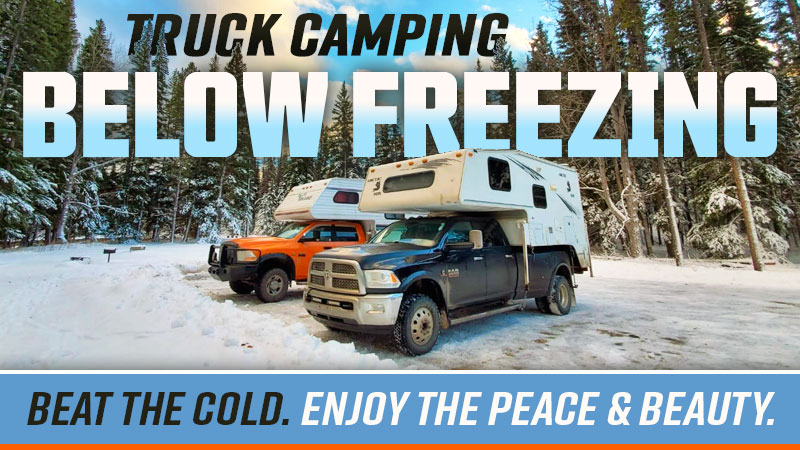
Last fall, we publicly admitted that winter camping isn’t exactly our cup of cocoa. It’s not that we haven’t been camping below freezing (we most certainly have), but we much prefer temperatures commonly understood as T-shirt and shorts weather. With that, we asked if any of our readers thought we were missing something with our winter camping aversion.
Moments later our proverbial mailbox exploded with reader after reader expounding their undying passion for camping when and where the mercury hides. More importantly, these ardent readers offered helpful recommendations on how to protect your truck, camper, and personal well-being during these sub-zero experiences. If you’ve ever considered camping in the freezing cold, get a pen and paper and prepare for a masterclass in cold weather truck camping. And we warned you about the Snuggie. Get it, now.

Above: At Hoo Doo Ski Park in Oregon
“During Thanksgiving week 2018, I was camping in Spokane, Washington when highs were in the high teens to low 20 degrees Fahrenheit (-6.6 degrees Celsius).
I learned a lot about the camper on that trip and would not do it again with a stock setup. More recently, New Year’s 2021, I went to Hoo Doo ski park in Oregon. That was a much better experience, except for having to chain up all four tires. The drive up was almost white out conditions for five miles. High winds and deep ice covered the roads, but it was well worth the stress. Highs were in the upper 20s to low 30s.
Since we received the camper in 2015, all of our cold-weather camping is in central Oregon. We do the Bend Ale trail in November and the weather is hit or miss. It’s either cold or really cold. On our way home, we always stay at Odell Lake. We have seen the lake frozen five feet out from the bank, but other times we have worn short sleeve shirts. There are no hookups due to the temperatures.
All of the ski parks are no hookups, so we rely on portable solar panels and our generator (if needed) to charge the batteries. Our batteries can handle about three days of our furnace running at 70 degrees. We make it work with a good campfire, good friends, and adult beverages.
We enjoy a good campfire, snowmobiling, sledding, skiing, just goofing off, and nothing serious. But the aspect of having good friends and a good campfire makes it the most enjoyable. Generally, anyone who is out camping in the cold is nice and just looking to have fun and get away. We have met some really nice people from all over the country. We don’t ski much, but we met a guy from Colorado who was traveling the west coast trying to ski everything.
We don’t plan on using the water but put some in the tank anyways. We have used it for the toilet with no issues except for the week of Thanksgiving in Spokane where we realized our basement wasn’t really heated enough at those temperatures. We make sure we have at least 100-feet of extension cords to plug into if needed. We also now have portable solar panels and a small generator.
My wife had the fresh water freeze once. Our pump is under the step to the cabover bed so we leave that hatch open in addition to the under-sink door when we are not in there. I also added a fan to the pump area. We keep the furnace at 70 degrees Fahrenheit (21.1 degrees Celsius) and have a small fan to circulate the air better.
We have added one-inch rigid foam insulation to the cabover and use a small fan to get warm air up there too. Primarily in the cold weather, we use the camper to sleep. Adult beverages during the day and evening seem to help, at least for me.
“Hot cocoa, coffee, adult beverages, or snacks can make another person’s (or yours) day if they are stuck. I’ve helped a number of people out. Just be ready and relax. Don’t go out of your comfort zone.”
Our advice is to not be in a hurry. Make sure you are full of propane and the batteries are charged. Have a backup source of 110-volt power, either shore or generator. Solar doesn’t do you any good if you drain the batteries too far. If you are going to take the camper off the truck you must factor that power draw while off-grid.
Make sure you have enough water bottles in case your pump freezes. We usually camp off-grid and far enough away from stores that we have to be self-sufficient for a few days. Have enough supplies to share. We have run into people either not prepared or in a real pinch.
We love cold weather camping for the unique experience it offers. I love the sun, but I also love the snow. I wouldn’t do the Ale Trail any other way; campfire next to a frozen lake with good company and drinks. It’s the same feeling as being on the beach with good company and drinks for me. We have snow toys and water toys. I would rather camp in the snow than the summer with the boat.” – Mike Meagher, 2015 Dodge Ram 2500, 2015 Wolf Creek 840
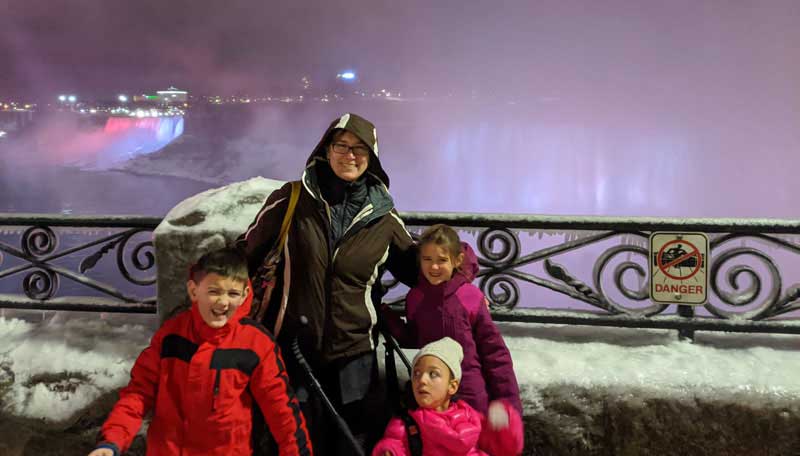
Above: Niagara Falls
“The coldest I’ve camped at is -30 degrees Fahrenheit (-34.4 degrees Celsius) in Minneapolis, Minnesota. I travel for work and bring my whole family of five. Sometimes my work is in cold snowy places.
We can comfortably stay without much thought down to 15 degrees Fahrenheit (-9.4 degrees Celsius). Below that, I use layers of protection. Last year, I installed a timer and valve to recirculate the water back to the fresh tank to prevent freezing in the pipes, especially in the slide-outs. We also run the propane furnace and have an electric blanket on the bed.
“Prepare to use a lot more propane when you camp in the cold. The hardest thing is to find fresh water during the winter.”
I like the challenge and the beauty of winter camping. It is easier to find solitude.” – Dusty Beasley, 2019 Ram 5500, 2015 Host Mammoth
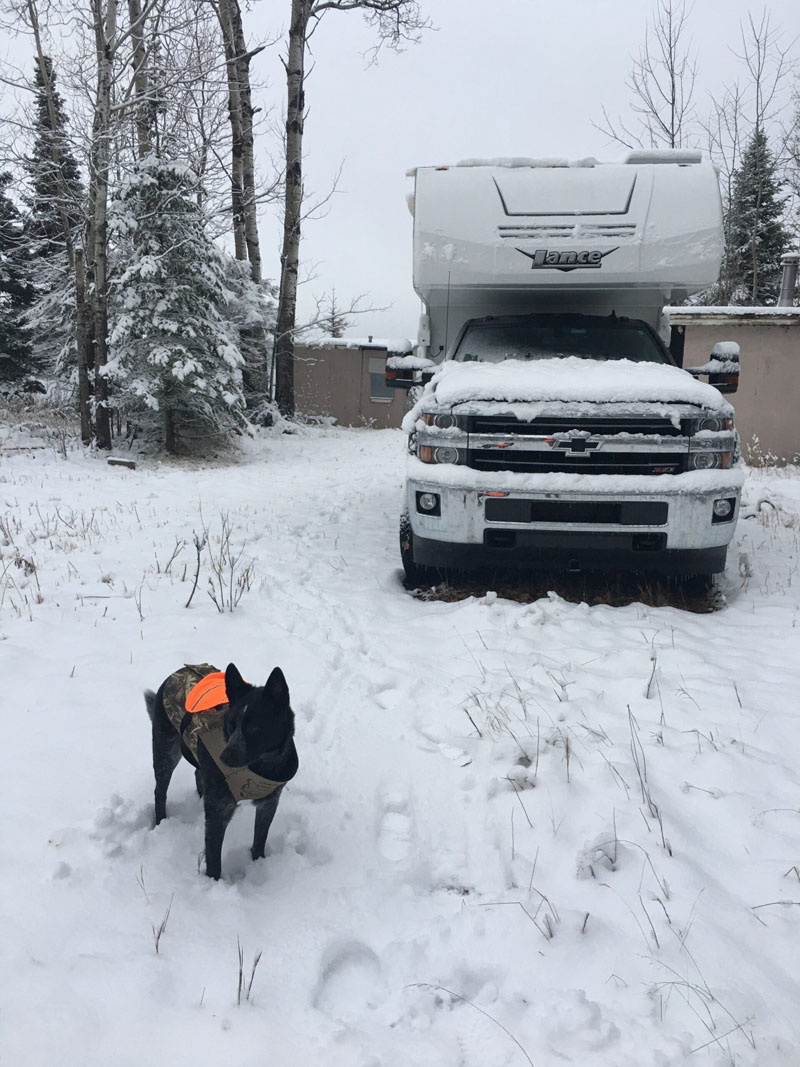
Above: Makinen, Minnesota
“The lowest temperature I’ve camped in was 13 degrees Fahrenheit (-10.5 degrees Celsius) in rural St. Louis county about 100 miles north of Duluth in northern Minnesota. I’ve dealt with frequent snow, as much as 6 inches at a time.
During the cold weather, I hunt grouse, ducks, pheasant, turkey, and woodcock. I’m also building a cabin. I camped on the shore of a small lake with no amenities and no hookups. Solar is not effective when covered with snow and ice. I have a generator and a portable power station.
After charging the camper battery and power station, I power everything down to prioritize the furnace – no TV! Flashlights are only for light, coolers or outdoor storage in lieu of the refrigerator. When the battery dies, I hook up the power station to get by.
Extra blankets, clothing, and insulation are a must. I carry an adapter to use small camping bottles if I run out of propane. I have a backup propane heater and an electric heater that can run off the generator. There are lots of backup plans, but I also have a place to go if everything fails.
“Make sure you have backup plans for heat and power and accept the fact that at some point you will battle the cold.”
My truck has an extra battery under the hood and I have jumper cables long enough to reach the external terminals on my camper. My camper is a four seasons model, so I assume it’s ready.
I have not camped below zero, but I leave the interior cabinet doors to the plumbing open when the temperature drops below freezing. I use my window covers and extra insulation under the bed. Humidity is always a concern so I keep small towels handy. I also have a blanket to cover my dog.” – Jeff Nichols, 2019 Silverado HD, 2019 Lance 865
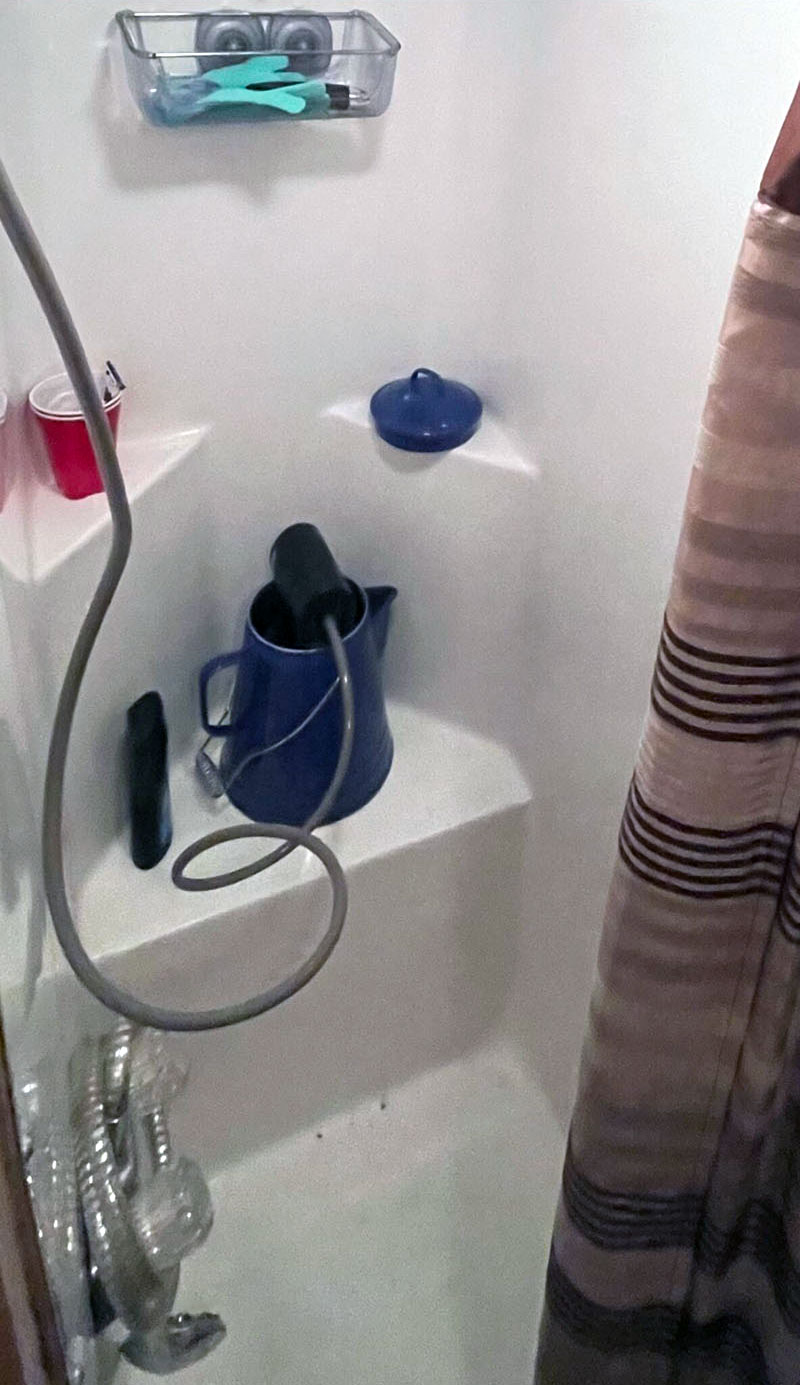
Above: Nukusp, British Columbia
“The coldest I’ve camped was at -40 degrees Celsius (-40 degrees Fahrenheit). In the winter, I enjoy snowmobiling and skiing.
Halfway Hot Springs, need I say more? There is nothing for services, and unfortunately not even cell service, but there is 106-degree water. There is no place to change. However, you’re good and warm when you get out! It’s absolutely amazing.
“Winter camping is a secret you’ll have to try. It is absolutely amazing to be out in the middle of a snowstorm camping!”
I drain and do not use any systems in my camper, but I do use an aftermarket Dickinson Propane marine heater. I winterize it all, but I have my own shower that I use snow to melt and have the best shower.
Go out and have a great time you learn as you go!
Winter camping is a secret you’ll have to try. It is absolutely amazing to be out in the middle of a snowstorm camping!” – Mark Kuzmicz, 2009 GMC 3500, 2011 Capri Camper
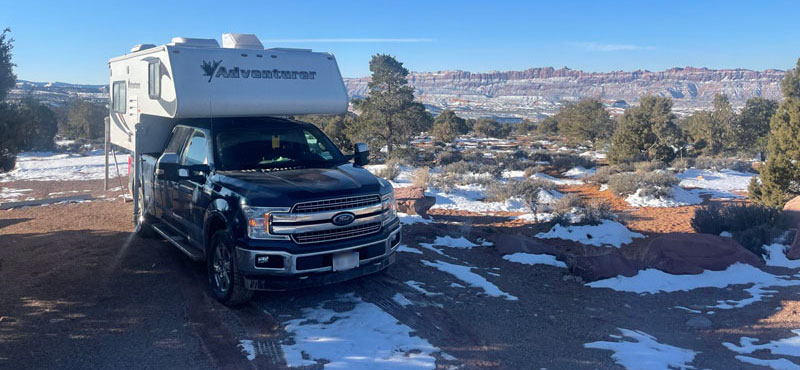
Above: Hovenweep National Monument, Utah
“We have camped in Moab and Colorado in February usually going hiking and visiting the national parks. The temperatures have been as low as 16 to 17 degrees Fahrenheit (-8.8 to -8.3 degrees Celsius).
We usually do a late February or early March trip. Generally, we dry camp, even sometimes overnighting in Walmart parking lots. We have two 100ah AGM batteries and plenty of solar. The furnace and warm blankets are generally enough.
On these winter trips, we don’t fill the fresh water tank and use RV antifreeze to flush the toilet. My wife made insulated window covers and we cover the ceiling vent hatch. We have never had our grey or black water freeze. We just add a little RV antifreeze to the grey tank.
Our furnace works fine and keeps us warm. We keep the thermostat set around 65 degrees Fahrenheit (18.3 degrees Celsius) to save propane. We only have a 20-pound bottle, so we usually fill it every three to four days. We could go longer, but it’s better to be safe than sorry.
“Everything looks better when there is snow on it.”
Our winter camping advice is to get out and have fun. Bring games, books or something to watch on television. It gets dark early. Cover the windows. They are our biggest heat loss. Everything looks better when there is snow on it.” – Matt Wiegand, 2019 Ford F-150, 2017 Adventurer 80RB
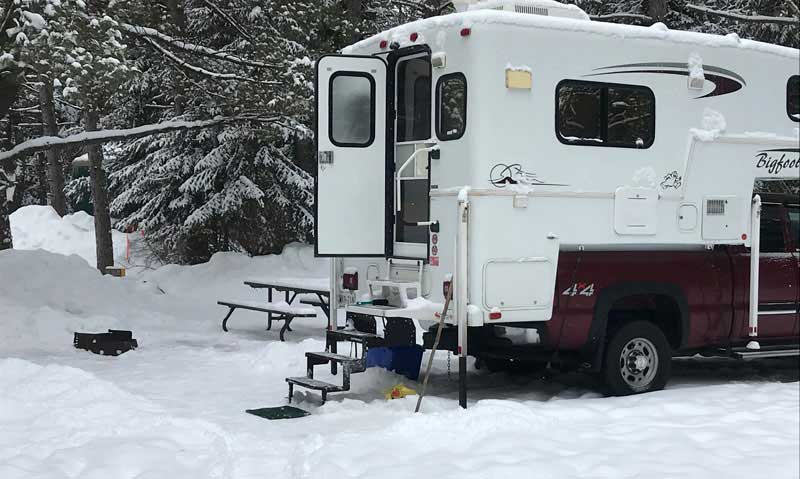
Above: Algonquin Provincial Park, Ontario, Canada
“Camping in a Bigfoot at -20 degrees Celsius (-4 degrees Fahrenheit) in Algonquin Provincial Park in Ontario has been my coldest temperature.
At Mew Lake Campground, lots are open with 30-amp electricity, fire pits, heated restrooms, a skating rink, cross-country ski trails, and walking trails.
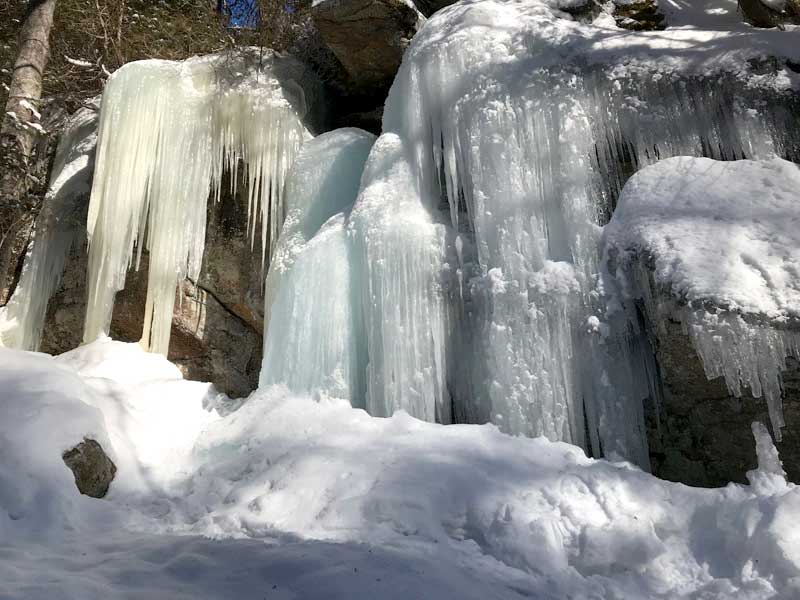
In the winter, we skate, ski, walk, and enjoy the fire. We have electric heaters and plenty of bottled water, though there are potable water faucets in the laundry room. In the cold, we do use our black and grey water tanks.
In the camper, we keep the temperature at 70 degrees Fahrenheit (21.1 degrees Celsius) with an electric heater. The furnace can kick in if needed.
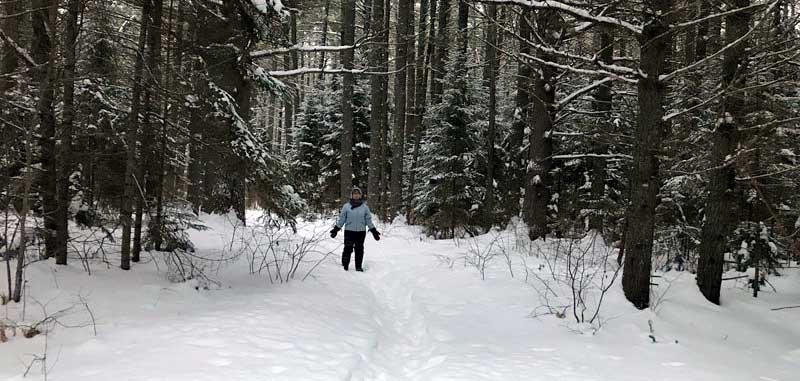
My advice is, don’t forget your winter jacket!
It is so different to camp in the winter. There is nice, cold fresh air when you go out for winter activities in the wild!” – Réginald Lafrance, 2004 Silverado, 2006 Bigfoot 9.4
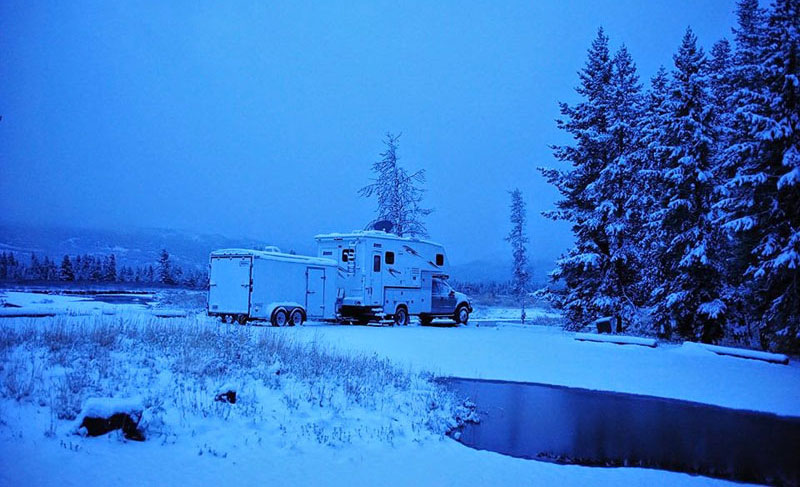
Above: Grand Teton National Park, Wyoming
“During the years I was full-timing, on the road, I have experienced many days below freezing while boondocking. The cold weather locations included Grand Teton National Park, Alabama Hills, Mojave Desert, Death Valley, Chihuahuan Desert, and Lake Texarkana. Camping has been at formal and informal campsites, as well as curb and/or dry camping.
The coldest was when I was in Kansas boondocking at a ranch pond when it crept down to -8 degrees Fahrenheit (-22.2 degrees Celsius) overnight. I was there for multiple days when it did not get above 11 degrees Fahrenheit (-11.6 degrees Celsius) during the daylight hours.
In the cold weather, I don’t winterize my potable water system. To accomplish this, I use a variety of techniques in accordance with the temperature. If the temperatures are in the mid-20s to 30s degrees Fahrenheit (-6 degrees to -1 degrees Celsius), I just open up the faucets and cabinet doors where there are water pipes and use the camper’s furnace. I supplement with a Wave catalytic heater. I carry a maximum of 119 gallons of propane with me. When the temperatures dip down to the low 20s, I use a small thermostat-controlled ceramic heaters in critical locations, such as the valve box running my generator.
Over time I have determined the weak areas of my camper and concentrated on those areas. As mentioned earlier, I keep a couple of small ceramic heaters in my valve box and release pressure from the water pipes by opening the faucets and cabinet doors during sleeping time. In addition, I use my Wave catalytic heater and multiple down comforters.
“I learned the hard way to move items, like can goods, from cabinets that have a surface with the outside wall.”
I learned the hard way to move items, like can goods, from cabinets that have a surface with the outside wall. I also pull in my slide as that is a drafty heat loss area.
I keep auxiliary heaters in my potable tanks and run the generator to power these heaters. It is just a matter of cycling rather than running them continuously.
To keep warm, I keep my heater running, camp in areas that have more winter sunlight, like the Mojave Desert, and pack warmer clothes.
If winter camping is something you would like to do, do it! Preparation is important. Remove all items that can freeze from your camper or locate them in areas that your camper’s heater will heat. Go out on short trial trips to see where the weaknesses are in your camper. The biggest is the humidity and moisture buildup when you use propane. My techniques for this are a whole different article.
If you camp in campgrounds, find ones that still have power and plug-in. Carry a couple of inexpensive ceramic heaters and use those. Winterize your camper and just put a Walmart blue water container on the counter and use that for personal needs and cooking. I often do this even in the summertime just to avoid putting water in my camper for short trips.
For me, winter camping is about not wanting to lose a season of adventuring so that I can continue to explore this wonderful country. Plus, there are fewer people to navigate through state and national parks, exhibits, and museums. By just changing your travel areas to the southern part of the country, you can avoid the extreme cold of the north.
I love the beauty, the solitude the quiet places as well as the people I meet along the way. It is really true what they say about, ‘Road Magic’.” – Bryan Appleby, 2008 Ford F550, 2008 Lance 1191
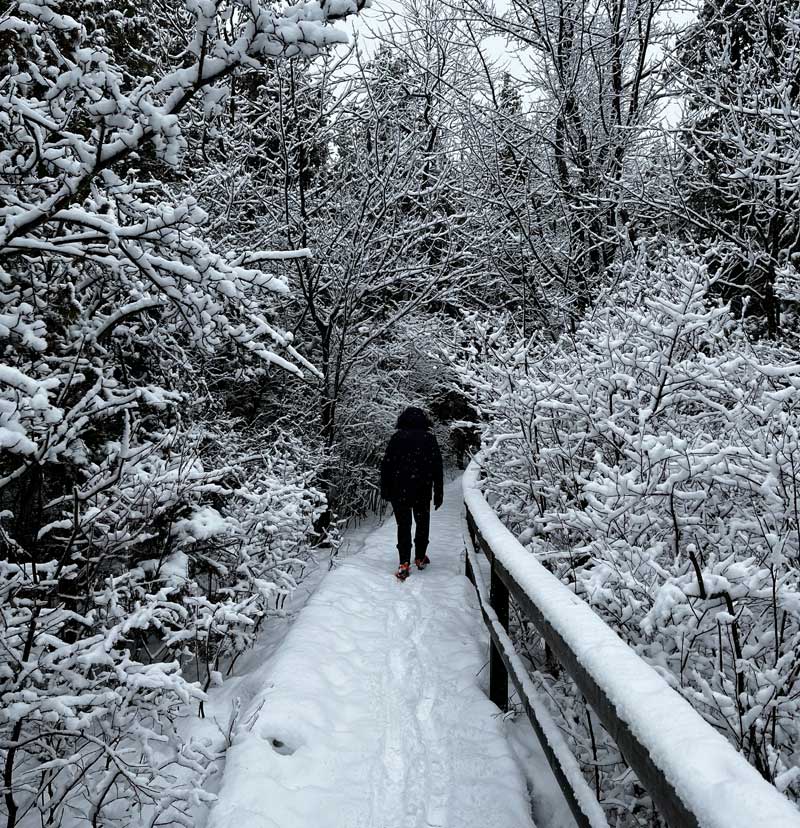
Above: Beautiful trails at MacGregor Point Provincial Park
“My wife and I have winter camped a few different times with the coldest temperatures getting near zero Fahrenheit (-18 Celsius) in Algonquin Provincial Park in Ontario.
Our late fall and winter camping experiences have all been at Provincial Parks in Ontario. We’ve winter camped at the Pinery, MacGregor Point, Silent Lake, and Algonquin Provincial Parks. These parks provide 30-amp electric hookups and water is available at comfort stations. Roads and campsites are plowed to allow access.
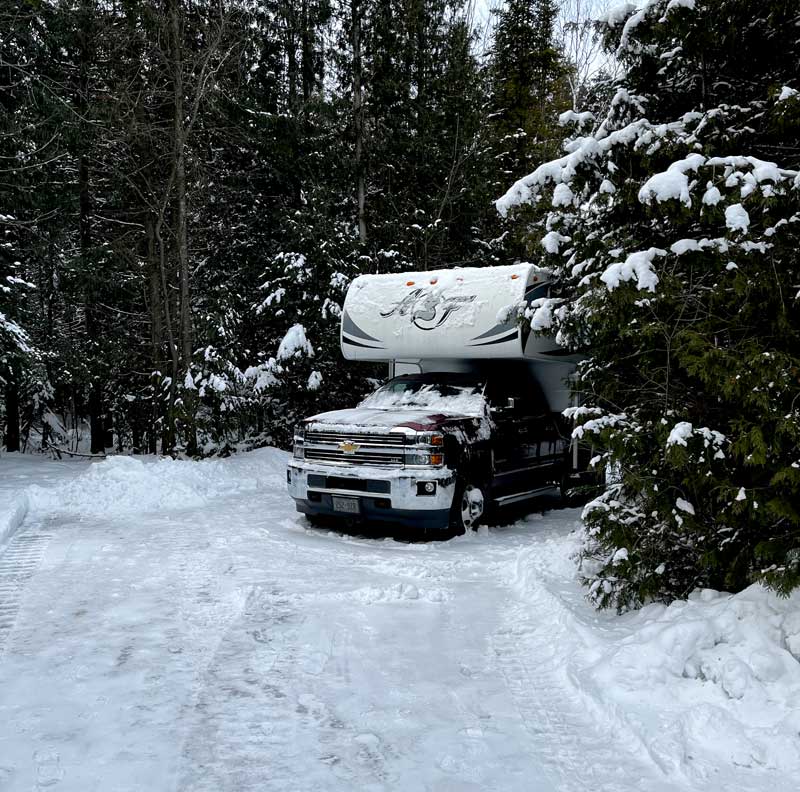
Above: Plowed roads at MacGregor Point Provincial Park
Winter camping provides an opportunity to get away from home during the cold winter months. We enjoy hiking, snowshoeing, and looking for signs of winter wildlife. We also enjoy a winter campfire. This was especially important for us during Covid as traveling to winter climates was difficult.
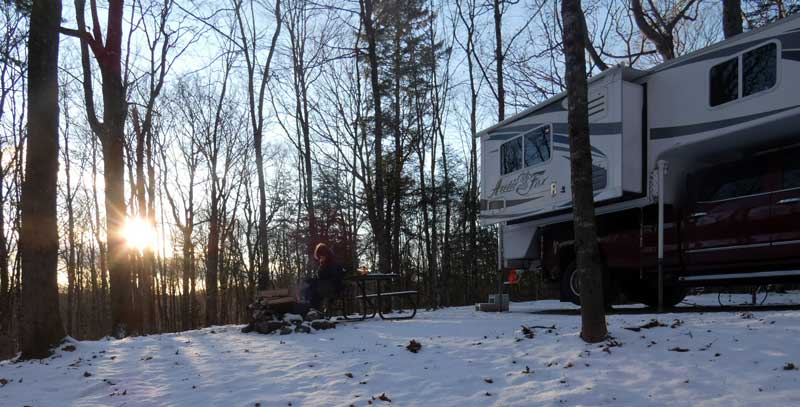
Above: Camping at Silent Lake Provincial Park
Since our Arctic Fox is four seasons rated, we camp using the fresh, grey, and black tanks. Fortunately, the dump stations at the parks where we camp are open year-round. We have added a light bulb in the area where the dump valves are located to keep this area from freezing in the very cold weather.
The furnace in our Arctic Fox keeps us toasty warm. We sometimes use a small electric heater to lessen the propane usage, however, care must be taken to keep the basement area warm.” – Roger and Lori Hyatt, 2015 Chevy 3500, 2015 Arctic Fox 990
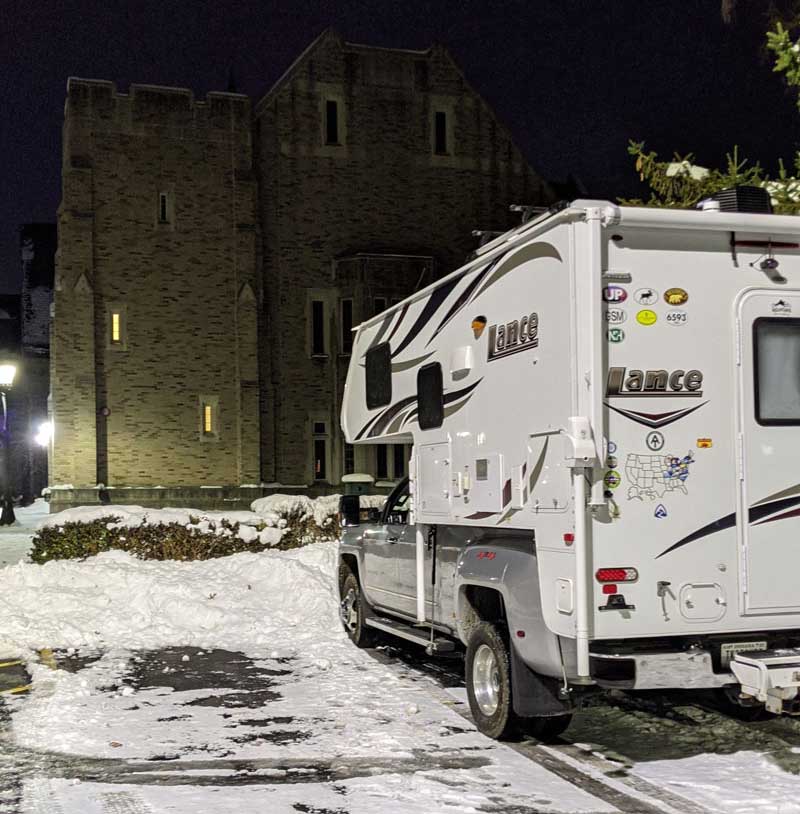
Above: South Bend, Indiana
“Our coldest truck camping temperature was boondocking in zero degrees Fahrenheit (-17.7 degrees Celsius) in Byron City, Michigan. The photo I sent in was of a boondock location in South Bend, Indiana.
Our son plays travel hockey and we have been known to sleep in the ice rink parking lot (with permission, of course). We have a Lance 850 and does very well down to zero.
There are only a couple of special provisions that I have allowed for. One is a sheet of rigid insulation under the camper in the bed of the truck. The other is cutting custom Reflectix pieces to cover all openings and then placing the snap covers over top of those. We still camp with fresh water like it’s 70 degrees out. Although, monitoring propane consumption requires a little more attention.
“We still camp with fresh water like it’s 70 degrees out.”
Much of our time is sitting around waiting for the next hockey game, so we do the same things we would do at home; sit around, cook meals, and watch TV.
There is nothing special to do to prevent freeze-up. The tank storage is heated with air ducts from the factory. I did install a thermostat in the underbelly just to monitor the temperature. I find it runs about 10 degrees cooler than that of the living space. When we exit the camper for a few hours, we turn the heat down to about 55 degrees Fahrenheit (12.7 degrees Celsius) to reduce propane consumption and limit how much space has to be reheated.
We don’t wear sock hats and coats inside the camper to stay warm. We just dress in layers, just like we would anywhere else. The bedding has a set of sheets, a fleece blanket, and a very heavy wool blanket. Pull them up tight and settle in for the night.
Our use is a little unique. If we don’t take the rig, we will be in a hotel. We prefer to take our hotel with us and save $150 a night. Depending on the length of stay and distance from home, we have to weigh the cost of diesel versus the cost of the hotel. With current fuel prices, there are times when staying in a hotel and eating out may actually be less expensive than packing up the rig.” – Jason Powell, 2019 Chevy 3500, 2018 Lance 850
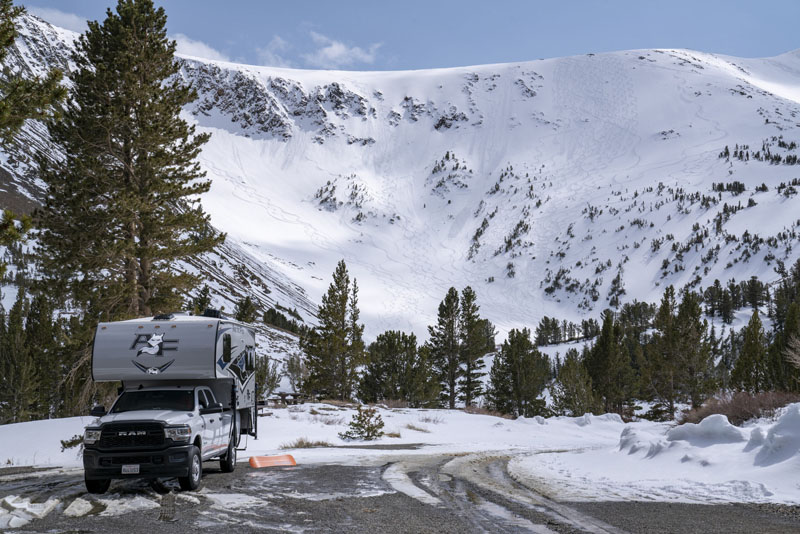
Above: Virginia Lakes, California
“In my pop-up camper a few years back, my coldest was around 6 degrees Fahrenheit (-18.3 degrees Celsius) in the Eastern Sierra near Lee Vining, California. Last winter 2021/2022 in my new Arctic Fox 865 the temperature was 17 degrees Fahrenheit (-14.4 degrees Celsius), and that was at Virginia Lakes, in the Sierra of California. The cold was no problem for that camper.
In the winter, I go to Bryce Canyon National Park, around southern Utah, Yosemite National Park, and Lee Vining, and (less often) along the Sierra/eastern Sierra mountains of California, from Alabama Hills to Lake Tahoe.
I rarely camp in campgrounds, so I am almost always boondocking, therefore there are no amenities. I have two 6-volt batteries that came with my Arctic Fox 865 camper. I run the heat to the mid-60s before bedtime, then set the furnace on low overnight.
Photography, snowboarding, and snowshoeing are what I often do for winter camping activities. Sometimes when my wife is along, we are at ski resorts for the day. Other times we are in a backcountry setting. Sometimes mountain biking at lower elevations where there is no snow, but it’s often below freezing overnight. Coming back to a warm camper after an active day out in the cold is the best.
My Arctic Fox 865 is a four-seasons camper. I still use Reflectix insulation cut to size in all the windows of the camper. If the sun is out during the day, I take the Reflectix off the windows to let the sun help the low furnace setting heat up the camper.
I also bring a few five-gallon jugs of water for drinking and cooking. The water system stays winterized all winter. I do not use the water system, except in spring when I know the temperatures are not going much below freezing.
“Camping in winter can be challenging, but it is quite rewarding and even mesmerizing with snow on the mountains.”
When I am out snowboarding, I set the thermostat to low so there is always some heat in the camper. For night time the bed has a normal mid-weight bedspread. I always have two quilt-style sleeping bags along; one is 20 degree rated, the other 40 degree rated. On colder nights I can temperature regulate with the quilt sleeping bags. Even a hat and socks go a long way to keeping comfy. I usually will set the thermostat somewhere around the low to mid-40s.
My advice is to know what your camper limits are. Be sure you have the power needed to heat the camper constantly if you have water in the camper’s water system. Use Reflectix or similar thin insulation for windows and even low storage areas.
Camping in cold around the Sierra usually means there is snow. It can be magical to be out in snow-covered meadows and mountains.” – David Clock, 2021 Ram 3500, 2022 Arctic Fox 865
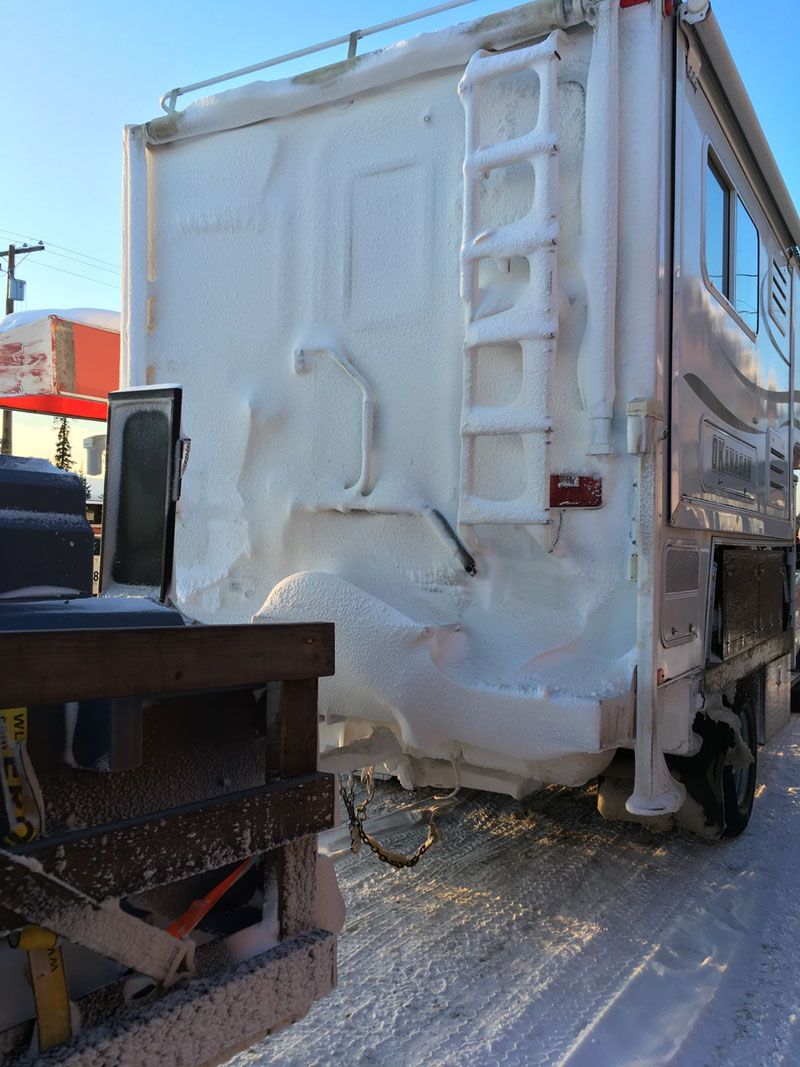
Above: Snow on the camper in Saskatchewan
“The coldest we’ve camped was -35 degrees Celsius (- 31 degrees Fahrenheit) in Northern Saskatchewan. We were on our way to look at some property in Northern British Columbia. It was only -17 degrees Celsius (1.4 degrees Fahrenheit) at that location. We were most anxious to get there.
We generally don’t camp in campgrounds, so carrying extra propane and sometimes batteries is a must. A generator is nice at times. Our last couple of campers have had solar panels, dual propane tanks, dual batteries, and are much better insulated, but I still carry extra propane.
During the winter, we have found that you can pretty much camp overnight in pull-outs, parking lots, and pretty much anywhere you can find a spot. Nobody else wants to be out in this weather, so you’re not likely to be hassled. They will just figure you’re either stupid or desperate or best not to bother with.
One thing we learned early on is that you really don’t want to stop and have lunch in your camper when it is below -20 degrees Celsius (-4 degrees Fahrenheit). By the time you stop, fire up the furnace, and start making lunch, it just never really warms up in that amount of time. You end up eating a somewhat cold lunch, and it’s generally uncomfortable. You are better served to stop in restaurants at those temperatures.
At the end of the day when you have parked somewhere, that’s the time to fire up the furnace and get things heated up. And a hot rum never hurts while you’re waiting for everything to defrost.
My wife and I regularly travel in the winter, primarily to go to town and get supplies, and to go to appointments. It is not really something we are passionate about, although I do like to eat, so maybe that counts.
Our early campers were not designed to handle really cold temperatures. We took five-gallon jugs of water with us. We would use them to fill a kettle, and that hot water could be used for washing dishes, bathing, etc. We didn’t have a toilet or grey water in those days.
Our last camper, an Okanagan, was great in the winter. Camping at -27 degrees Celsius (-16.6 degrees Fahrenheit) was no problem with full tanks of water. We never had an issue. When it’s that cold I leave the furnace and water heater running while traveling. At night it never hurts to leave the cupboard doors near water lines open for extra heat. We always take extra propane with us. You can not always count on being able to top up.
“For winter camping in comfort, my advice is to buy a better quality camper designed for cold weather camping. You’ll thank me later.”
If your batteries run dead because you have over-taxed your furnace, you can always fire up the truck for extra power to start the furnace again. If you run out of propane, you’re heading for town or home. There is no way to make up for that. I have been there, done that at 3:00am. I would have rather been sipping coffee at six instead of driving.
The easier way to be comfortable is to turn up the heat. This also keeps everything else from freezing. If that is not an option, then you have to pack water in the cab where it’s warm, or at least sloshing around. That’s not as convenient as having 45 gallons in the belly of your camper, but it is still doable. There are a few things more uncomfortable than crawling into a bed (think foam mattress) in below-freezing temperatures! The mattress feels like a brick. It’s colder than all @#$%, and takes forever to warm up. If you can afford the extra propane, keep that furnace on!
If you only have one battery, carry two spares. You can easily suck one battery dry overnight running the furnace. During the day while traveling, charge the battery with the lowest state of charge. It is a serious drag getting up in the middle of the night in cold weather with the wind blowing and having to swap out a battery just to keep warm.
For winter camping in comfort, my advice is to buy a better quality camper designed for cold weather camping. You’ll thank me later. Also, carry a generator and a small catalytic heater. This will work surprisingly well assuming your generator will run in those temperatures. Get a Honda and, if necessary, put a cardboard box with holes over it. Or, if you can find a campsite with power, Bob’s your uncle; plug in and enjoy.
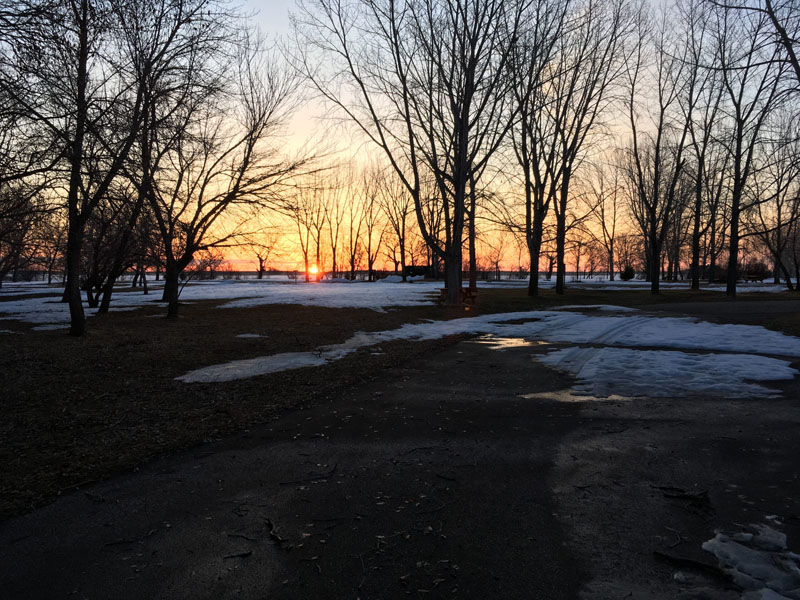
Above: Saskatchewan in the winter
I can’t say I love winter camping, but I grew up and live in northern Canada. Aside from moving south, we just have to deal with it. Once you become accustomed to traveling and camping in below-zero temperatures, it is not a real problem. You just have to be prepared for it.
Some of the harder things are finding a dump station, and even worse is a place to fill with fresh water. It is well advised to spend some extra time planning your trips in cold weather so you can address these issues. I have found that even in spring and late fall it can be an issue to find a place to dump and fill. I have often pondered the pros and cons of a composting toilet for this very reason. You can always fill bottles of water in a gas station/restaurant etc, but once the black water tank is full, there is a different sense of urgency.” – Kevin Mooney, 2014 Ford F-350, 2006 Okanagan 106UDB
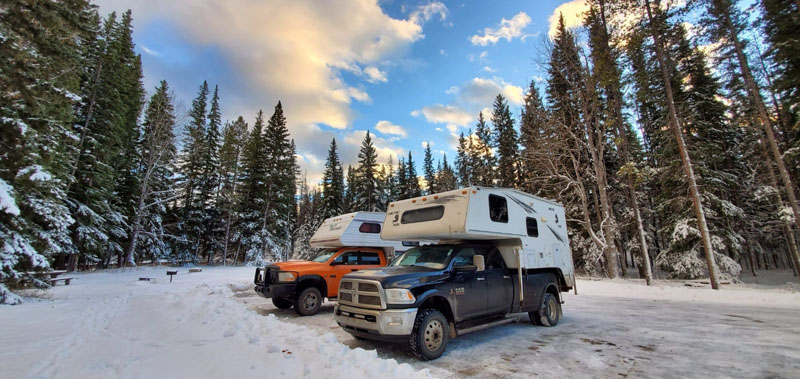
Above: Banff and Jasper National Park
“The lowest temperature we endured was -21 degrees Celsius (-5.8 degrees Fahrenheit) in Jasper National Park in Canada. It was by accident because the forecast said -10 degrees Celsius (-14 degrees Fahrenheit), but we survived.
We camp anywhere in the Canadian part of the Rocky Mountains. Nine out of ten times it’s boondocking because most of the campgrounds are closed. We make sure that batteries are always topped up and propane tanks are full before we leave. We use windshield washer fluid to flush the toilet and water containers inside the camper so it won’t freeze.
We go skiing, snowshoeing, hiking, and hang out with friends. The cold makes everything harder, but most of the time we get areas to ourselves. We can dress for the cold. Negative twenty with sun and no wind is not that bad if you’re doing stuff you like.
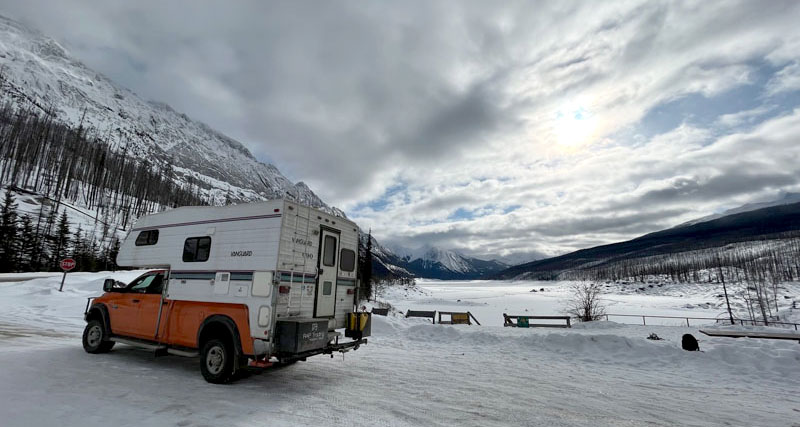
We had a three-season camper until last winter. We just made sure it was properly winterized. We keep the heater running and bring lots of warm drinks. We always keep our service up to date. As a mechanic who also runs a service truck, I hate working in the cold if I’m off.
“We can dress for the cold. Negative twenty with sun and no wind is not that bad if you’re doing stuff you like.”
We are now waiting to get our new Arctic Fox 865. We hope to run that next winter, and see how winter camping is in a proper four-season camper.
We only use the black tank because we have no heat pads or heated basement. We are using windshield washer fluid to flush the toilet.
We recommend that you run the heater in the camper so things won’t freeze, even when driving. Bring more blankets and wear proper clothing. Preparation is key. Make sure that you are prepared for the worst, and it can only be better. Look at the weather forecast all the time.
We like the quietness when there is snow on the ground, beautiful blue skies, and the winter activities.” – Martien and Roeby Brand, 2011 Ram 3500, Vanguard C90
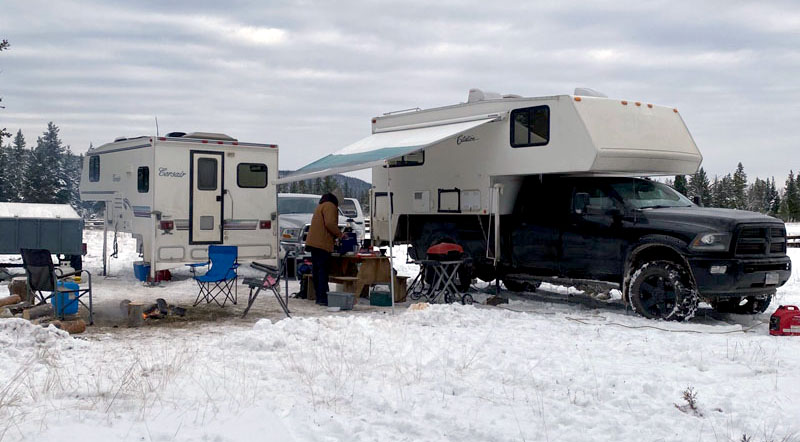
Above: Chilcotin, British Columbia, Canada
“I’ve camped in the Chilcotin region of British Columbia at -20 degrees Celsius (-4 degrees Fahrenheit) during the day and -28 degrees Celsius (-18.4 degrees Fahrenheit) at night.
Most campsites are closed in the late fall in British Columbia. While boondocking in cold temperatures, we use our Honda EU1000i at night. The fuel tank lasts about eight hours, which is perfect.
Our 1999 Citation 10’6 has a heated basement and an air duct up to the cabover. We also use a heating pad to warm the bed and/or a Milwaukee battery fan to circulate air to the cabover. Extra 20-pound propane tanks are a must for extended stays. Two 20-pound tanks will last about four days in -15 degrees Celsius (5 degrees Fahrenheit) to -20 degrees Celsius (-4 degrees Fahrenheit) heating the camper.
We use all plumbing as normal in below-freezing temperatures. The furnace works well. A small wood stove would be an ideal supplemental dry heat.
“We enjoy the nice, crisp beautiful mornings, and the big warm campfires at night. We also like the lack of people around.”
Start with a camper that is designed for cold temperatures in the first place. Bring along spare propane. Seal any air leaks with tape or rigid foam.
We do some yearly fishing trips at the end of October. We enjoy the nice, crisp beautiful mornings, and the big warm campfires at night. We also like the lack of people around.” – Brandon Cryderman, 2014 Ram 3500, 1999 Citation 10’6
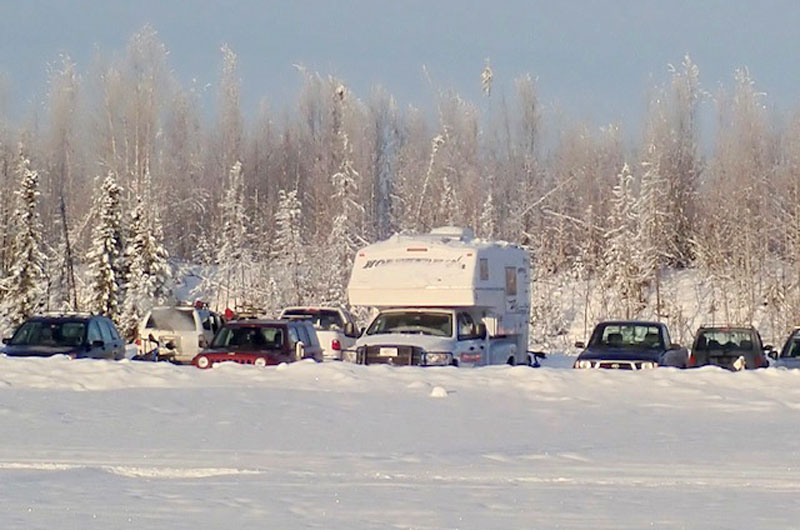
Above: Big Lake Alaska for the Fat Bike Snow Race
“We live in Anchorage, Alaska. I think the coldest we’ve camped was about -15 degrees Fahrenheit (-9.4 degrees Celsius) north of Big Lake, Alaska.
We do a few overnights each year throughout the winter. We have a 2010 Northern Lite 10.2 which has great insulation. We usually dry camp due to a lack of open campgrounds. We have not had a problem with the electric fan running the propane heater. Our lights have been switched to LEDs and, in the winter, we minimize our power usage.
We have Bluetooth temp sensors with alarms set if the temp in the camper gets below 40 degrees Fahrenheit (-4.4 degrees Celsius). The temp sensors are in the enclosed tank dump locker, under the dinette seat, in the living area, and outside.
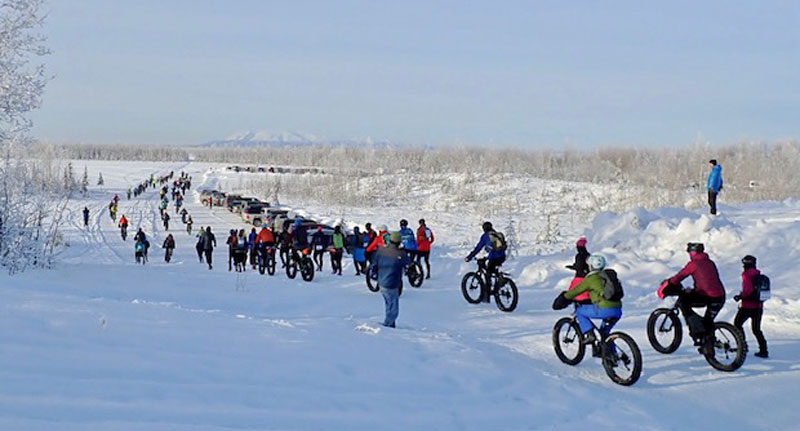
My wife and I do some fat bike races here in Alaska in the winter. We use our rig for warmups when we train. We are able to camp before and after the races. We also go out with friends and hike and fat bike during the season.
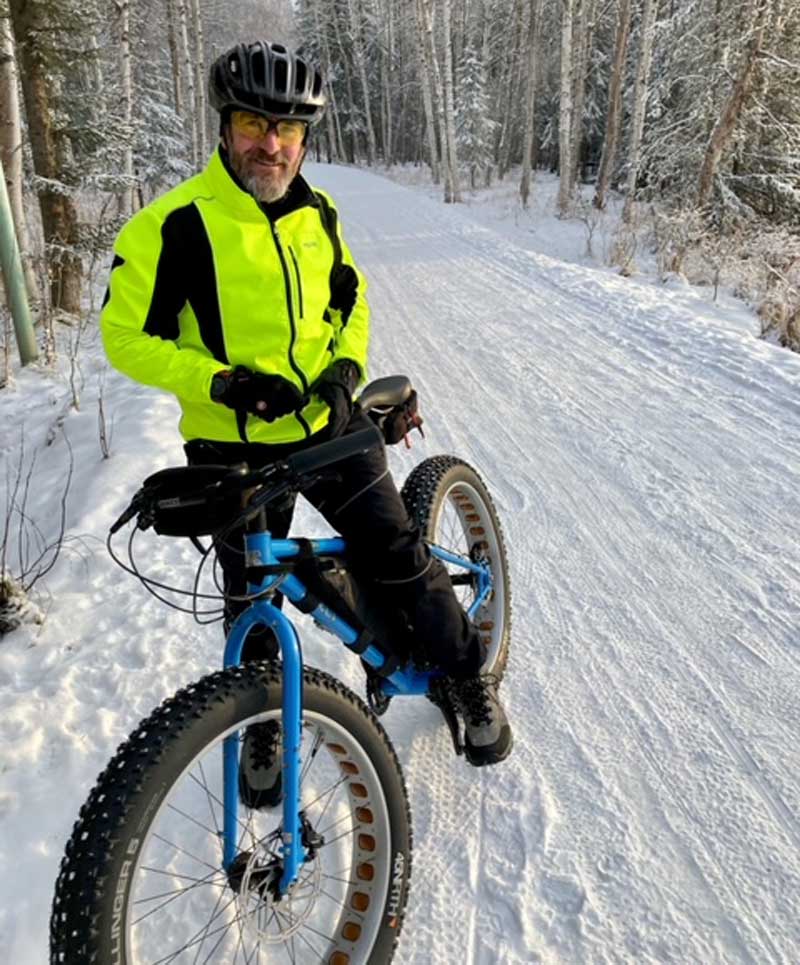
Our Northern Lite 10.2 has great insulation, but I added insulation in the water/drain dump cabinet. We have two 400-watt solar panels and three lead-acid batteries. Our main issues are on the short days keeping the panels clear.
We usually use portable one and five-gallon jugs for water and heat water on the stove if needed. We can empty the grey and black tanks when we get home.
We use the black and grey tanks and leave the winterizing antifreeze in place for the fresh water system. Five-gallon fresh water jugs supply our water. We heat fresh water on the stove for dishes and washing.
“It’s great to have our own mobile cabin to warm up when we’re biking or hiking. It extends the winter days by having a place to hang out and get out of the cold and warm up before going outside again.”
Our Northern Lite’s propane heater has an outlet that heats the basement tanks and the cabin heater is across from the bathroom, which is above the water/dump cabinet so it stays warm enough. We start the heat as we are loading the camper until we dump so things stay warm enough.
I ensure that we have two full propane tanks. We also dress for the weather and anticipate a cool camper. We plan to use the stove more than normal so that will also add to the camper heat.
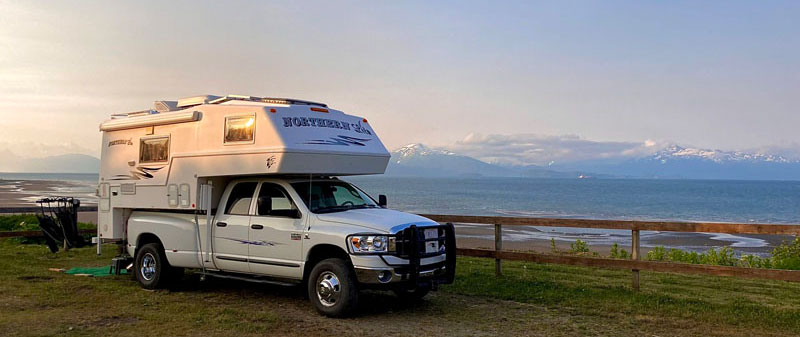
Above: Homer Bluff, Alaska
Living in Alaska, camping in the cold extends our camping season. It’s great to have our own mobile cabin to warm up when we’re biking or hiking. It extends the winter days by having a place to hang out and get out of the cold and warm up before going outside again.” – Bill McKeon, 2007 Dodge Ram 3500, 2010 Northern Lite 10.2 CDSE
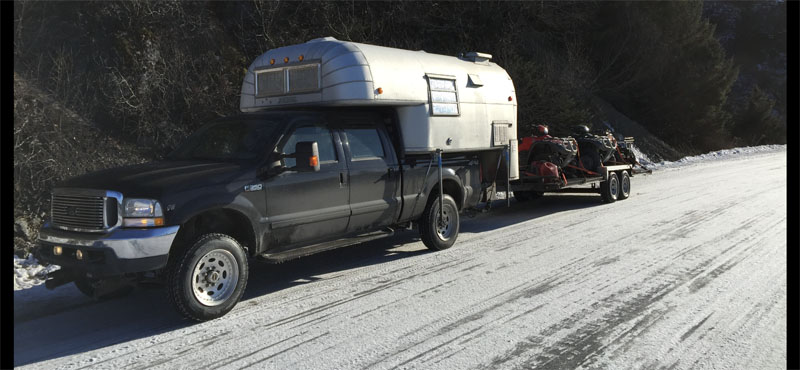
Above: Kodiak, Alaska
“We took two different trips both around Thanksgiving to Anchorage, Alaska from Kodiak, Alaska. The first time we camped it was 10 below zero Fahrenheit (-23.3 degrees Celsius) several nights in a row and the second time it as low as -16 degrees Fahrenheit (-26.6 degrees Celsius). Both trip temperatures never were above zero.
We have camped below freezing and many times below zero in Anchorage and Kodiak, Alaska, Ellensburg, Washington, and Ely Nevada. Sometimes we have shore power other times we have a Honda generator until we bed down. Then we bring the generator in until morning.
A lot of times we are just winter traveling and take the camper for saving costs. Other times we have taken the ATVs to the frozen beaches of Alaska and have enjoyed playing without anyone else bothering us.
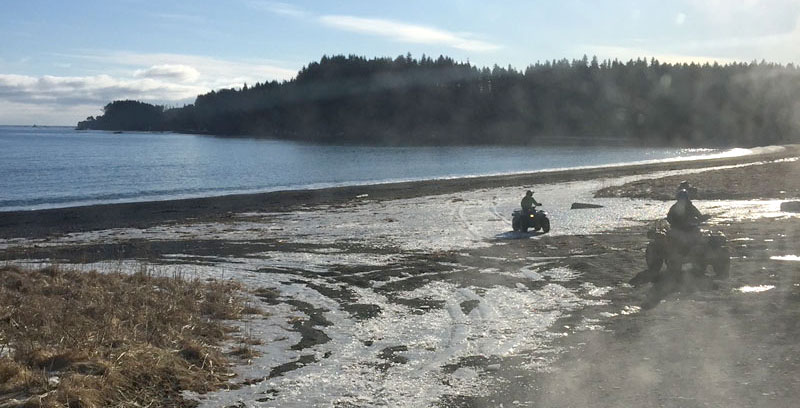
We drain the water tank and remove the water pump and leave it at home. We have added Reflectix insulation in the windows and added pink foam board insulation under the bed in the cabover. We dump the recirculating toilet and put in three gallons of -50 degree Fahrenheit windshield washer fluid and the toilet chemicals. We bring one-gallon jugs of water for water use.
The fresh water tank stays empty. The grey tank stays empty even though we do put RV antifreeze in the sink trap and drain valves. We have a stand-alone Thetford Electra Magic recirculating toilet that takes a three-gallon charge for flushing with toilet chemicals. In winter that charge is not water but -50 degree Fahrenheit windshield washer fluid.
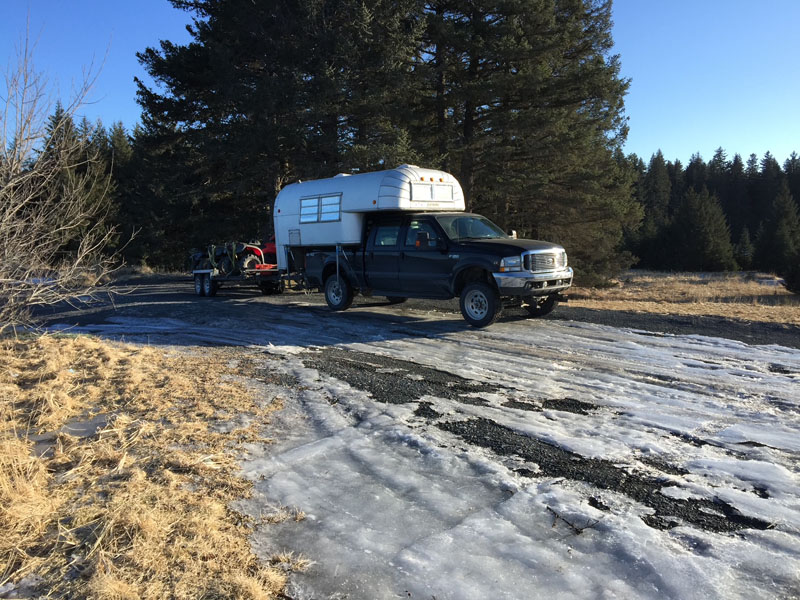
“We like the lack of people, the beauty and quiet of winter snow camping, and a full pot of coffee!”
Down to 25 degrees Fahrenheit (-3.8 degrees Celsius), our 3000 BTU catalytic Wave 3 heater does great. Colder than that, our 17,000 BTU forced air heater does fine as long as we either have shore power or are running the generator. Otherwise at those low temps the batteries will only last five to seven hours.
If in snow country, we carry “cam-lock” style chains and practice installation at home so they go on and off real quick when needed. Cold starts for the truck at -10 to -20 degrees Fahrenheit are fine, but make sure you have good synthetic oil and a good battery.
We like the lack of people, the beauty and quiet of winter snow camping, and a full pot of coffee!” – Garry Kernan, 2002 Ford F-350, 1966 Avion C-10
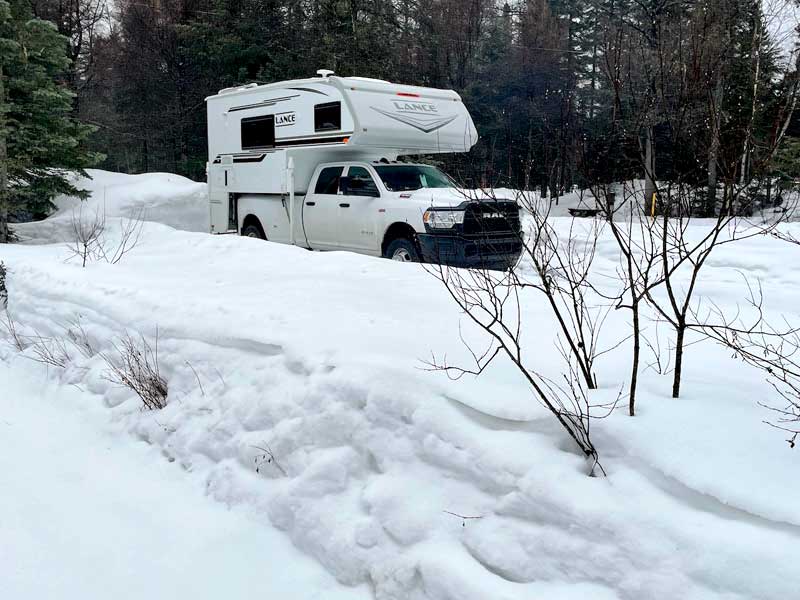
Above: A campground in the Laurentians, Quebec
“The coldest we experienced was -30 degrees Celsius (-22 degrees Fahrenheit) in Roxton Falls in Quebec, Canada with 90 kilometer-per-hour winds. That was our first trip in our brand-new Lance 960.
We had a water jug and the rig was winterized while we were getting used to it all. We were plugged in at the local campground, so we used a combination of electricity and propane to keep warm. We were comfortable but worried about all the wind. We did lose our FM antenna to a falling branch, but it was later replaced by the RV dealer.
We camped all over Quebec last winter and our biggest problem was finding places to dump our tanks and fill with fresh water. The best campground we found was ‘Camping Du Lac Morin’ in Notre-Dame-Du-Mont-Carmel. Try saying that three times fast! They have excellent facilities with brand new washrooms, laundry room, WIFI, and available fresh water. Their rates were very reasonable.
But there was nowhere to dump our tanks. The best place to take care of our liquids was in Granby. At the arena they have a dumping station and potable water open all year. We ended up going back there quite a bit.
Cross-country skiing is our main reason to go winter camping. There are lots of great trails throughout Quebec, but the best free ones are at Parc des Chutes in Shawinigan Sud and Parc Michel Chartrand in Longueuil. Both sites have lots of groomed trails that are perfect for classic or skate skiing.
I really enjoy the snow. We didn’t have much of it when we lived in Nova Scotia. So we sold our house, ordered a truck and camper, and moved to Quebec. My wife enjoys snow as well but we have to make sure we have a toasty warm place to retire at night.
“In the winter, the advantages are that there are no bugs to worry about and a lot fewer people are camping.”
The Truma Combi in the Lance 960 is perfect for winter camping. It’s very efficient at half the weight and space. It’s the main reason we bought our Lance 960 truck camper.
Our truck camper is four seasons and has held up rather well. We added Reflectix to our windows, but everything else is stock. Now that fall is here and the temperature dips close to freezing on some nights, we make sure the furnace is on to keep everything from freezing. When it’s very cold the exhaust from the Truma can freeze and plug up the outlet. We just clear the ice and all is well.
Our tanks are well insulated and get heated by the Truma Combi. We keep the inside warm and the basement gets heated at the same time. Condensation is an issue with winter camping. Every morning we go through a routine of removing the condensation from our windows and have a small dehumidifier we use when plugged in, which is at least once a week.
While we were getting used to the truck camper, we had an electric blanket to help warm up the bed. We found out our truck FOB can stop working (when frozen) and now we know how to get it going again. If it gets really cold we consider getting a motel room or at least going to a campground where we can plug in.
My advice is to go with a proven four-season camper model and enjoy winter camping. Have an alternative heat source to stay warm in case the Truma breaks down, like a Buddy heater. Start at campgrounds, if possible, so that you can get used to winter camping.
We love cross-country skiing and anything to do with winter. Well, maybe my wife is not quite as attracted to the colder season. She will not ski if colder than -15 degrees Celsius (5 degrees Fahrenheit), but we still manage to go for walks and to keep life interesting. In the winter, the advantages are that there are no bugs to worry about and a lot fewer people are camping.” – Yves Chartrand, 2021 Ram 3500, 2021 Lance 960
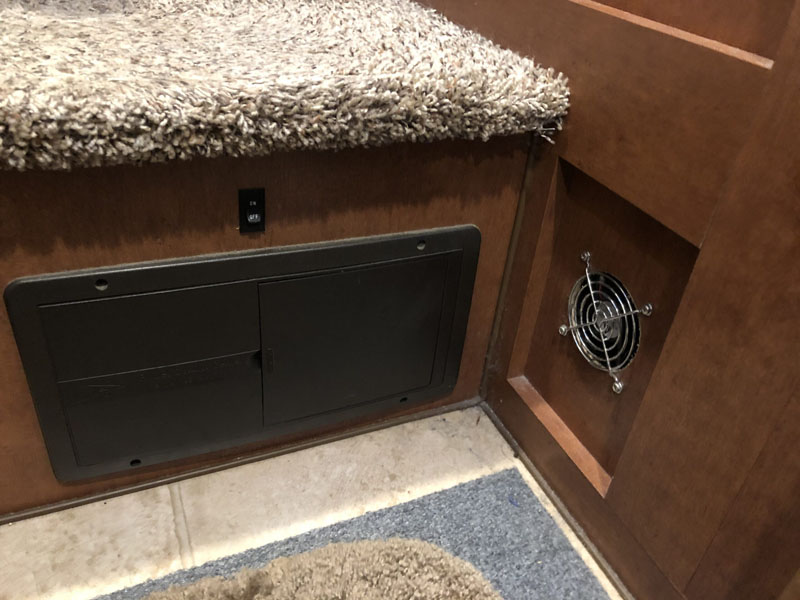
Above: Photo of fan pushing warm cabin air into the basement
“I picked up my 2016 Arctic Fox 865 in Billings, Montana in February of 2017. The night temp hit -24 degrees Fahrenheit (-31.1 degrees Celsius) . . . yes, 24 degrees below zero. It still worked great!
Of course, I had to leave the furnace and water heater on all the time, even while driving, as I headed back to my home base in Massachusetts. I also picked up a portable 12-volt clip-on fan at a truck stop that I clipped to the closet in front of the bedroom. The fan blew the warm area from the main kitchen area to the chilly bedroom area while sleeping. I found it could get chilly up there without the fan at those temperatures.
Meredith Woods Campground in Meredith, New Hampshire is open year around. Sites have electricity and dump, but no fresh water during the winter months. My fresh water tanks needed to be filled at the office as I arrived and/or departed. It gets really chilly there, but winter walks with my dog through the woods and adjacent hills are beautiful.
I’m not a winter sports guy, but I love the serene beauty of the winter landscape. Also, I use my truck camper to travel to various events and venues around the country all year. That often involves boondocking at truck stops and Cracker Barrels in the winter months.
The Arctic Fox 865 is a true four-season camper. As long as the systems are left on all the time – furnace, water heater, and refrigerator – everything works fine in cold temperatures. I ordered the camper with dual pane windows, a generator (to charge the batteries when snow blocks the roof-mounted solar panels), plus extra AGM battery capacity to run the furnace blower and my CPAP on long cold nights.
When I’m at a campsite that has electricity, I save propane by using an electric radiant heater that I carry with me. A pair of computer fans keep the basement tanks warm when the propane furnace isn’t running. I also mounted remote temperature sensors in several places in the basement and in outside storage areas to send temperature readings to a monitor I keep inside. That assures me that all the nooks and crannies are well above freezing.
“I admit I hate being cold, so I keep the inside temperature above 70 degrees Fahrenheit (-21.1 degrees Celsius) all the time I’m inside.”
I admit I hate being cold, so I keep the inside temperature above 70 degrees Fahrenheit (-21.1 degrees Celsius) all the time I’m inside. When it’s really cold outside, and when I’m boondocking away from shore electric power, that can result in the depletion of the two 30-pound propane tanks in just a week or so.
I leave the heat and water heater on all the time. When I’m on the road and not inside the camper, I set the inside temperature at 55 degrees Fahrenheit (-12.7 degrees Celsius). Not only does that keep things from becoming “cold-soaked”, but it also keeps the ambient temperature high enough to keep the refrigerator running normally.
The refrigerator will stop cooling when the inside temperature approaches the refrigerator temperature, resulting in a shut-off and spoilage of the freezer contents.
I like the fact that my truck camper replaces hotels and airlines for virtually all my travel year around. I never winterize it. I just plug it in when I’m at my home base, keeping the water heater on electric mode, the electric space heater on to warm the interior, and the basement duct fans operating 24/7. That way I’m ready to travel anytime with virtually no prep.” – Reed Prior, 2017 Ram 3500, 2016 Arctic Fox 865
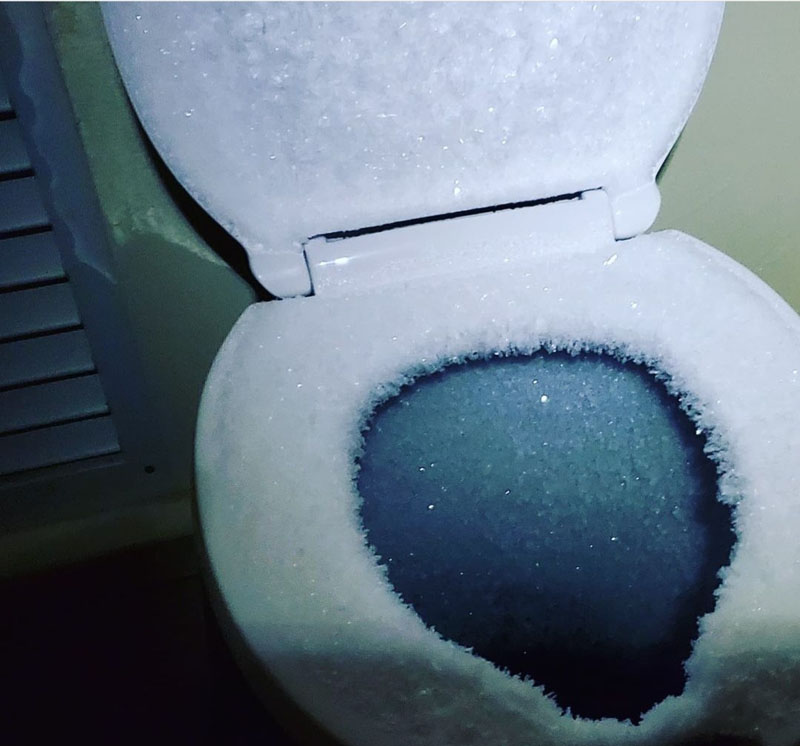
Above: Waskesiu Park, Saskatchewan
“I have been to Lake Waskesiu in Saskatchewan in the cold. There are several winter camping sites available. Firewood ready to be chopped is provided there and our site even had pit toilets.
We went snowshoe hiking and otherwise sat around the campfire and visited like most camping trips. My rig is self-built under a shell. I use special antifreeze meant for extreme cold as well as special wiper fluid that doesn’t freeze.
I use two duvets, one below, and one on top of me plus a -40 degree Celsius (-40 degree Fahrenheit) sleeping bag on top of that. I also wear a hat and warm bootie slippers.
“Winter camping is incredibly peaceful but, at the same time, victorious. It really makes you feel alive.”
My advice is to plan your meals carefully. Food freezes at extreme temperatures. Butane will not light in extreme cold. Have matches available and use a proper stove.
Loose layers are most likely to keep you warm, but always have a dry set of clothes available if you overheat. Even if firewood is provided, be sure to have an area to cut it into Burnaby pieces or kindling.
Pack your water in containers you can keep in your sleep system to keep it liquid. Finally, know your limits. It’s okay to say enough, and go someplace warm.
Winter camping is incredibly peaceful but, at the same time, victorious. It really makes you feel alive.” – Clarisa Morales, 2018 Ford F150, Self made camper
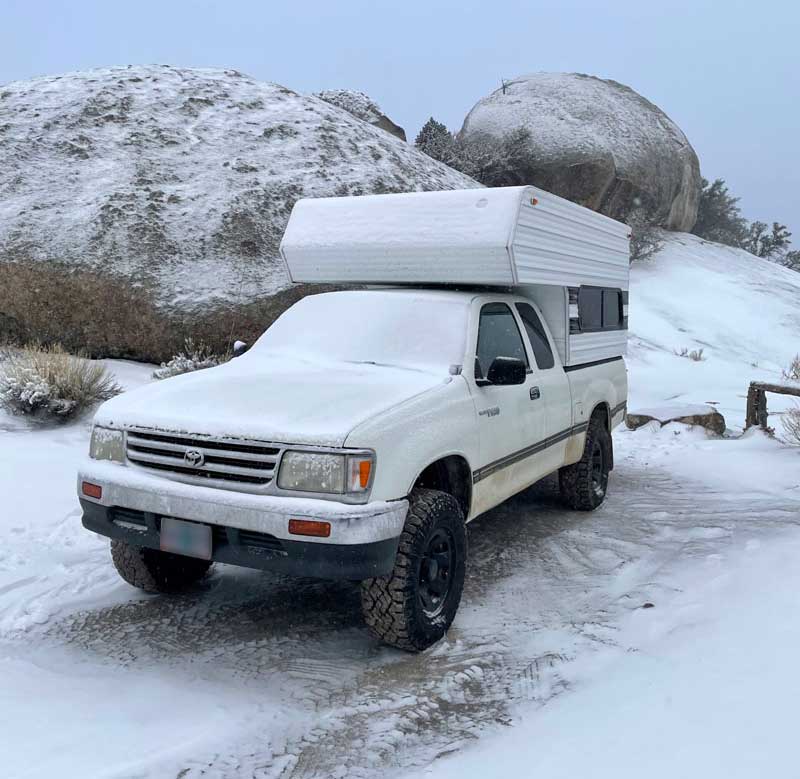
Above: City of Rocks, Idaho
“The lowest temperature I’ve camped in the truck camper was single digits in the City of Rocks, Idaho; 9 degrees Fahrenheit (-12.7 degrees Celsius) with a wind chill.
The places I’ve parked or camped overnight in below-freezing temperatures were in the City of Rocks, Idaho, and Deschutes National Forest. Both places were primitive camping. I made it work by having the right gear.
“I like to camp in the cold because of the lack of people.”
While truck camping in cold temperatures, I like to fish, backcountry ski, climb, and hike. I’m not super passionate about cold temperatures. It just extends the adventure season by being resilient and tolerant in less-than-ideal temperatures.
My truck camper is really well insulated. I have a good sleeping area and I use the Jackery for anything that needs to be charged or plugged in. I pee in a jar and have an emergency wag bag pooper.
Make sure you have good insulation and the right gear for the weather; lots of synthetic and wool. Get the right gear for the job and be prepared.
I like to camp in the cold because of the lack of people.” – Dillon Upp, 1996 Toyota T100, Custom USA Camper Shells
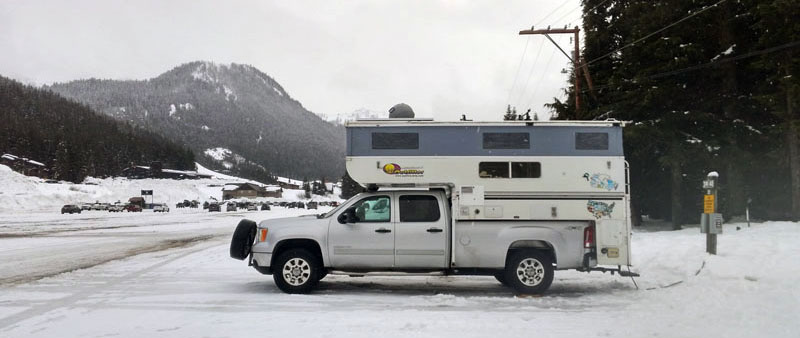
Above: Crystal Mountain, Washington
“The coldest I’ve camped was -22 degrees Fahrenheit (-30° Celsius) in southwestern Wyoming pulled over along US30 west of Kemmerer.
I camp at quite a few ski resorts as well as locations near or between resorts. I also do a fair amount of backcountry skiing in remote locations.
“I like all of the places I can go with my own personal hotel room.”
While camping, I watch hockey, football, a few movies, and occasionally read a book once the sun goes down, which happens way too early that time of year.
I use all the tanks and have never had an issue. Freezing hasn’t been a problem in my rig. My camper is insulated with a heated basement. I usually have a pullover fleece top on over normal clothes.
I like all of the places I can go with my own personal hotel room.” – Alan Whittern, 2012 GMC Sierra, 2007 Outfitter Apex 9.5
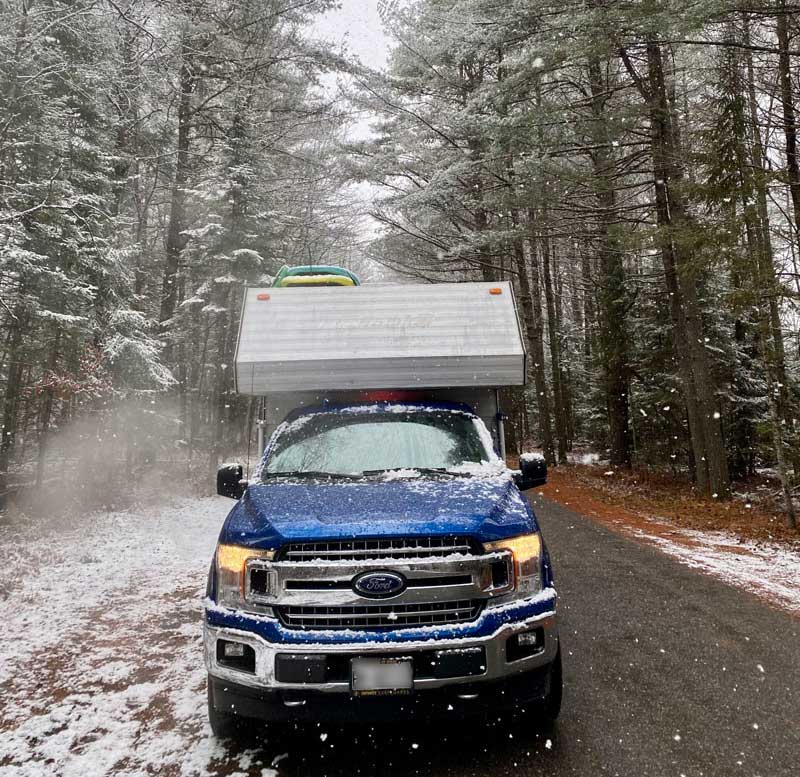
Above: Arrowhead Provincial Park, Huntsville, Ontario
“In February 2022, we camped for three days at -27 degrees Celsius (-17 degrees Fahrenheit) in Arrowhead Provincial park in Ontario Canada.
We have camped at Arrowhead Provincial park and Algonquin Provincial both in Ontario under 0 degrees Celsius and Fahrenheit. Both have full electric sites and a small number of winter sites available. No water, just electricity.
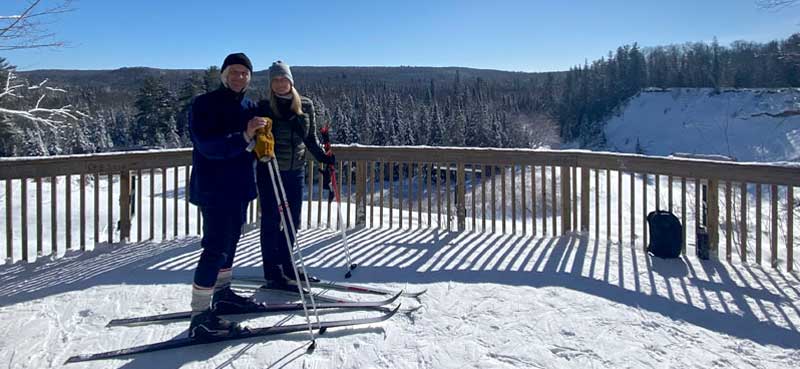
We hike trails and enjoy cross-country skiing and outdoor skating. We have also paddle-boarded on the lake during one of these trips, while it was snowing. That was breathtaking!
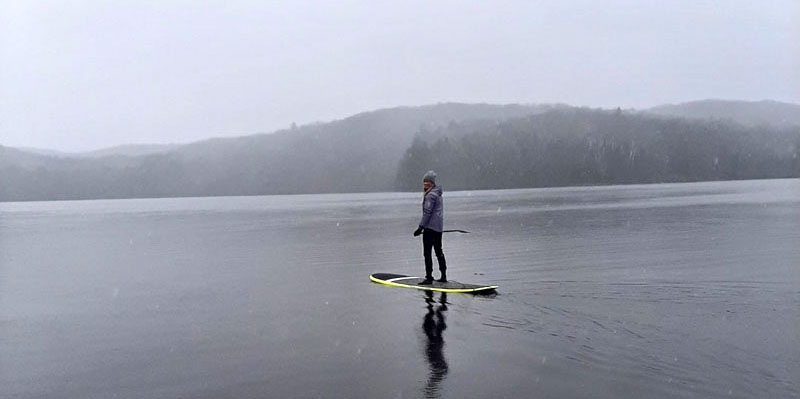
The only system we don’t use is the fresh water system. We drain it in the fall and add anti-freeze through the system to keep the components from freezing over the winter. We could use the fresh water system but the risk is the temperature when we are driving because we are not heating the truck camper. When we camp during this time we use containers of water in the truck camper.
We use our propane heater, and electric heater when plugged into an electric site. We have custom-cut a length of carpet to fit our floor to act as insulation and to keep our feet warm! When outside, we will sit by the fire and bundle up. During outdoor activities, it’s easy to stay warm when you’re moving.
“We love to use our truck camper year-round. It’s cozy inside when it’s cold outside and we love to play outside!”
We recommend that you insulate the floor with a carpet, and wear cold-weather clothing layers so that it’s easy to remove one or two when inside. Also, pack extra propane and lots of firewood.
We love to use our truck camper year-round. It’s cozy inside when it’s cold outside and we love to play outside! Some of the most beautiful mornings out of the truck camper window have been when the snow has fallen on the trees overnight.” – Heidi Gillis and John Daniels, 2018 Ford F-150, 2002 Travel Hawk
“I have boondocked in Gunnison and West Cliff, Colorado in freezing temperatures since most country campgrounds are closed for the winter season. During my third season of elk hunting in Gunnison, Colorado, it was -20 degrees Fahrenheit (-28.8 degrees Celsius). Brrrr!
I always have plenty of propane with extended stay connectivity. The overhead bunk has a -20 degrees Fahrenheit (-28.8 degrees Celsius) sleeping bag. With the furnace set at 54 degrees Fahrenheit (-12.2 degrees Celsius), it’s very comfortable as long as the wind is not too strong.
“I like being self-sufficient and having peace and quiet. But, I also enjoy the creature comforts like hot food, a warm bed, and warm feet.”
Having a warm kitchen to sit in while making a hot soup, tea, or cocoa is just awesome. I dry out my gear overnight and watch my favorite movie, or listen to good tunes. My batteries last about two days then I run the truck motor or the generator to charge them up.
My water system is not capable of use below freezing. We keep the water drained and use a five-gallon portable water tank. I use the fresh water pump to push RV antifreeze through the fresh water lines and engage the water heater bypass. When I camp in the cold, I just keep it drained and winterized.
The Thetford cartridge toilet does well if I keep manual anti-freeze flushing available and empty it regularly. There is no grey tank in my camper. My 1995 Co Lite Craft is only a three-season camper. It requires a lot of TLC, but the benefit is a low-cost stay.
I have serviced all the appliances keeping the furnace blower cleaned and lubricated every two years. The Atwood furnace is 18K BTU and it keeps us toasty, even down to -20 degrees Fahrenheit. It seems to run about a 60-percent duty cycle at that temperature.
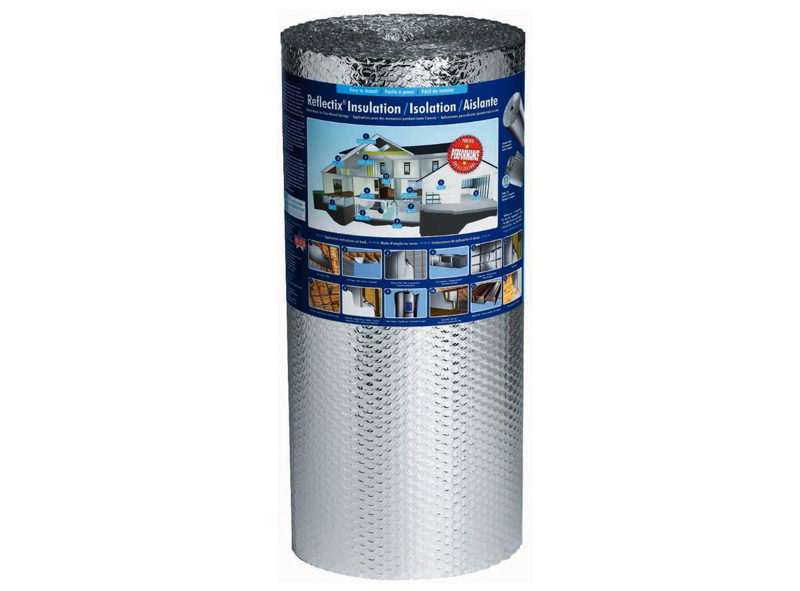
I have also purchased the double foil-faced insulation (Reflectix) to line the inside of the soft walls and hard wall windows. It is quite amazing the difference that it has made. On cool night camping at 35 degrees Fahrenheit (1.6 degrees Celsius) to 50 degrees Fahrenheit (10 degrees Celsius) the furnace doesn’t even come on till around 0530-ish. It makes for a quiet night.
Make sure you have a CO and a propane detector and that they are operational. Then test it every day! Truck campers are a tiny air volume. Your life may depend on it.
In the winter, the campgrounds and boondocking locations are almost empty. I like being self-sufficient and having peace and quiet. But, I also enjoy the creature comforts like hot food, a warm bed, and warm feet. Oh and a good movie with popcorn occasionally while alone in nature is also nice.” – Kerwyn Shafer, 1998 Chevy K2500, 1995 Colorado Lite Craft 8.5
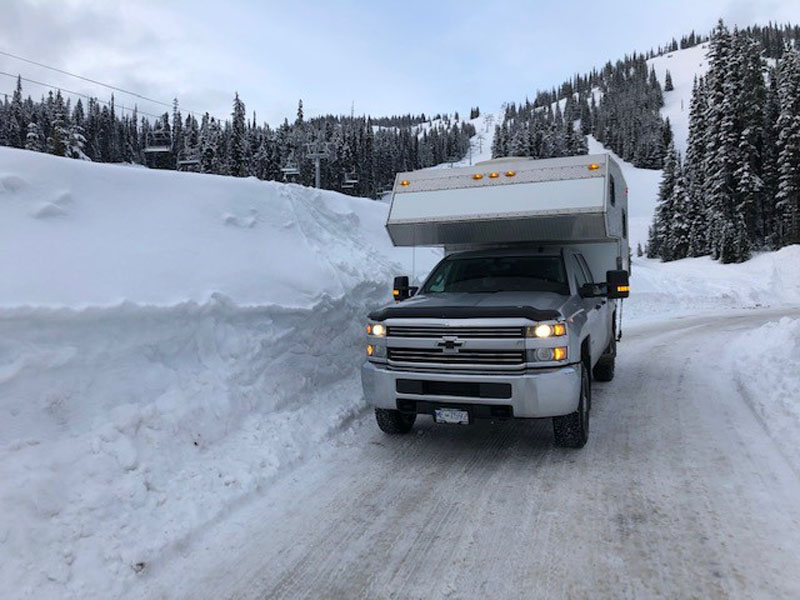
Above: Our old camper at the ski hill
“In British Columbia, I camped at -40 degrees Celsius (-40 degrees Fahrenheit) at the EC Manning Park ski hill and at the Apex Alpine ski hill. I go snowmobiling and skiing in the windows.
My windows and vents need covers. The foam is good. And we use the blue Ensolite sleeping pads that backpackers use.
My camper is built for the cold, but you must make sure heat gets into the tank spaces. I run the furnace and use a plug-in electric heater. It is easy to -20 degrees Celsius (-4 degrees Fahrenheit).
“You can use a hair dryer to thaw frozen windows that won’t open or close. Arctic extension cords are easier to roll up.”
The refrigerators work better on propane in the cold but you need to cover the bottom refrigerator vents outside up a bit or they won’t cool because it is too cold outside.
My advice is to add extra carpet on the floor and to carry water in jugs. If you have power, have a trouble light on bottles below -25 degrees Celsius (-13 degrees Fahrenheit) to warm the propane a little. If you have power, run an electric heater as well. You can use a hair dryer to thaw frozen windows that won’t open or close. Arctic extension cords are easier to roll up.
I love skiing and volunteer on the ski hill.” – Mike Bohn, 2008 Chevy 2500, Galaxie
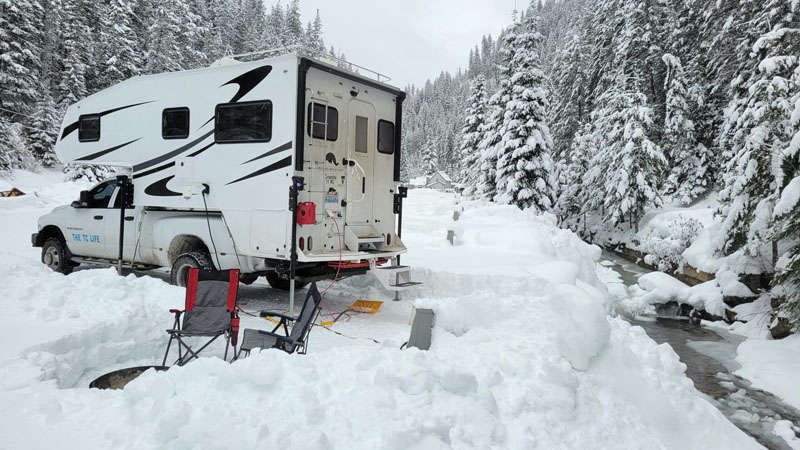
Above: Wallace, Idaho
“The coldest we have camped with our camper was -16 degrees Fahrenheit (-26.6 degrees Celsius). That was in northern Idaho during the Thanksgiving weekend in the camper we had before the one we have now.
With our new camper, the coldest has been in the single digits on the plus side of zero. That was in Wallace, Idaho during New Year’s Eve weekend. I am sure at some point we will be out in sub-zero temperatures with this camper too.
Winter camping takes us to a variety of places. Getting into the mountains is very limited due to access because of snow. Some places are simply too snowed in at times. Sometimes we go to a resort and sometimes just out boondocking. Of course, even at a resort, most services are shut down for the season. That is okay with us. We use electricity if it’s available.
“We live in the north, so winter makes up several months of the year. Either learn to love it or get cabin fever.”
We will go snowshoeing or downhill skiing depending on the snow of course. If there is little to no snow we will do some hiking. Geocaching is a usual activity for us as well. Most of the time we sit around a campfire. We still go outside, we just wear warmer clothes.
We winterize the fresh water system by blowing the lines out and putting some RV antifreeze down the drain. We then take fresh water in a container that we use for that time of the year.
We still use our grey and black tanks. We flush the toilet with RV antifreeze or winter washer fluid and do the same with the grey tank. It is important to note that our basement is heated with the use of our furnace.
We stay warm simply by reaching over and turning up the thermostat for the furnace. We paid a good amount of money for the features the camper has, so why not use them? We also have two seven-pound propane tanks. So that helps with the extra use of propane for heating more during cold temperatures.
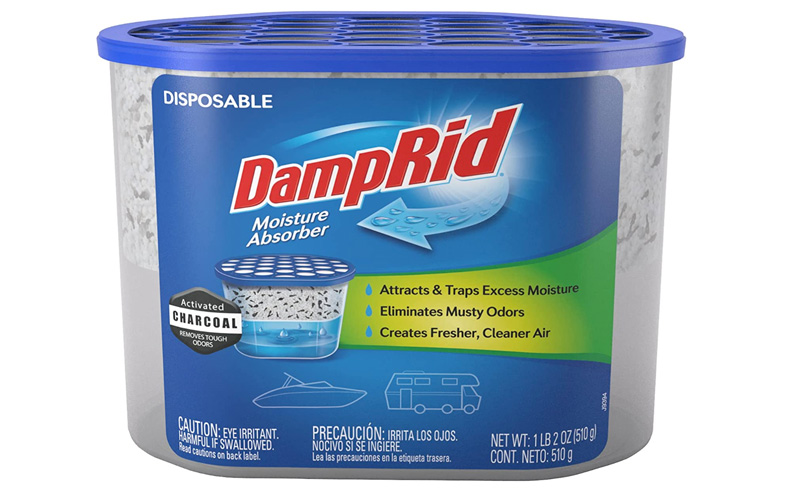
My advice is that you keep the waterlines safe. Sure it is nice to have the water system working, but taking bottled water and not using the fresh tank system is not too big of a deal. Also, keep a vent or window open slightly to allow moisture to escape. We also use the dri-air containers to help with moisture inside the camper.
We love how quiet it is in the winter. There are far fewer people out. We have been at campgrounds that have over 40 sites and we were the only ones there. We live in the north, so winter makes up several months of the year. Either learn to love it or get cabin fever. We bring plenty of warm gear to wear and embrace winter.” – Rich Bain, 2004 Dodge 3500, 2022 Rugged Mountain 11RL
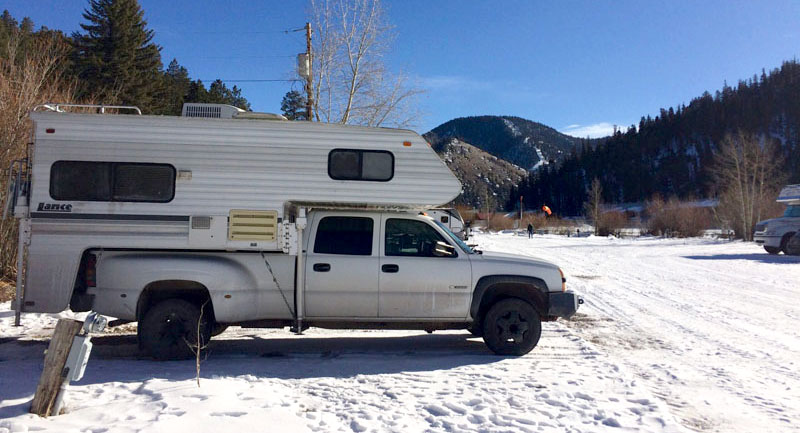
Above: Red River, New Mexico
“The coldest I’ve camped was when with lows were around 20 degrees Fahrenheit (-6.6 degrees Celsius) in Utah, Colorado, northern New Mexico, and the lower panhandle of Texas during a freak cold spell.
We’ve had power and water in some campgrounds, and no hook-ups at others. We’ve stayed in national park campgrounds, national forest campgrounds, and private campgrounds below freezing. We try to have power so can use a small electric heater instead of using the propane furnace. We tend to stay in places with no hookups in the summer.
Some places are much nicer in the freezing cold than in summer; for heat and amount of visitors. We drive around to sightsee, hike, and visit national parks. We are from northeast Texas and we like to go west to see snow.
“Some places are much nicer in the freezing cold than in summer; for heat and amount of visitors. We drive around to sightsee, hike, and visit national parks.”
We don’t hook up to water unless it gets above freezing during the day. We always unhook the water at night. When it’s freezing, we don’t run water in sink faucets but we do use the toilet and sink drains. We use RV park showers instead of the camper shower (which use during the summer).
Of course, we keep RV antifreeze in the holding tanks. We use a two-gallon water reservoir with a spigot that we bought at Walmart. We use everything. We just don’t run water in the sinks below freezing. We’ve never had any trouble in our 1997 Lance that has no basement heaters and we’ve never added heat tape anywhere.
We like going where it’s cooler (we live in Texas). There are far fewer people and we enjoy the snow and winter activities. We’re retired so have the time off.” – Connie Westbrook, 2005 Chevrolet 3500, 1997 Lance Squire 5000
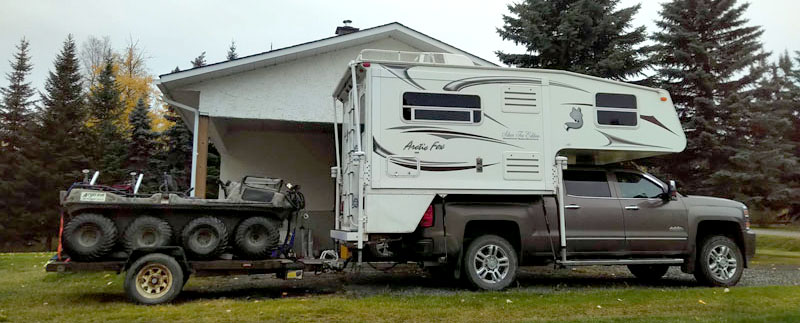
Above: Prince George, British Columbia
“The lowest temperature I’ve camped in is -8 degrees Celsius (17.6 degrees Fahrenheit) while hunting in northern British Columbia. We camped in a site with no amenities; just a formal pad with a fire ring and picnic table.
We hunt when the weather is below freezing. The hunt for moose draws us back every year. We have an Arctic Fox and it handles the cold pretty well. We have added a 315-watt solar system to keep the batteries charged and the furnace running.
We have a basement thermometer that reads out in the kitchen. We also run the furnace and pull the slide in at night.
Winter is a great time to be outside with no one else around. Have fun!” – Andrew Brink, 2015 Silverado 3500, 2010 Arctic Fox 811
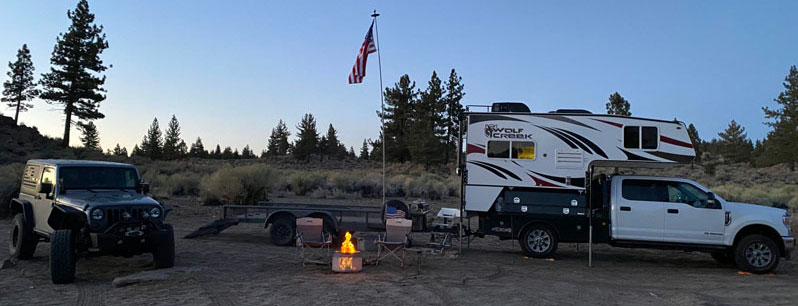
Above: Near Crowley Lake, California
“We camp in the Eastern Sierras in March every year. It usually gets down to -15 degrees Fahrenheit (-9.4 degrees Celsius) at night and into the high 40s degrees Fahrenheit (-4.4 degrees Celsius) during the day.
We love to go Jeeping and hiking during the day and sit around a big campfire in the National Forest at night. It is all boondocking.
Our camper, a 2020 Wolf Creek 850, is a four-season camper and has no problems with these temperatures. The sub-floor area (where the tanks are) is heated and has not frozen on us yet. We just keep the furnace set low when we leave for the day and have never had any problems. We do go through a lot more propane winter camping, but it is worth the beauty.
We keep the furnace at 60 degrees Fahrenheit (-15.5 degrees Celsius) and wear pants/sweatshirts inside. My wife likes to wear her Ugg boots to keep her feet warm, but socks do enough for me.
Make sure your camper is rated for cold weather or you will have problems. You need to keep the tanks and plumbing above freezing. Plumbing can freeze solid and/or break from cold.
Everything is so beautiful and crisp in the winter. There is usually no one else around for miles.” – Greg Hill, 2021 Ford F-350, 2020 Wolf Creek 850
“The coldest we’ve camped is about 4 degrees Fahrenheit (-15.5 degrees Celsius) in northern Wisconsin at the Seeley trailhead for Birkebeiner XC ski trail.
I generally camp at XC ski trailheads in northern Wisconsin and upper Michigan. There are no amenities. I train for cross-country skiing. It involves four to five hours of skiing each day. I eat a lot and spend like ten hours in bed to rest. My sessions last three to four days.
“The simplicity of the truck camper is conducive to focused training. I also enjoy defying to extreme elements of winter.”
I run my Honda EU2200i generator for an hour during supper to top off my 200 amp-hour Battleborn batteries. I turn the heat down to 55 degrees Fahrenheit (12.7 degrees Celsius) when I’m sleeping or skiing. Otherwise, it’s at 70 degrees Fahrenheit (21.1 degrees Celsius).
All the windows and vents are covered with two layers of Reflectix, glass and frames and velcroed to the walls. I installed two computer fans to circulate the living compartment air to the basement and to the insulated battery area.
I do not drain the plumbing. And I take showers. I need to be completely comfortable for recovery. As long as the furnace is functioning, I do not have problems with freezing the plumbing. I do carry a Buddy heater just in case the furnace fails. I would use it just to get me home. I have never used it.
Just an aside, above 6,000 feet, my furnace would not work. I had to go to a smaller gas orifice, reduce gas pressure .5 W.C. and install a more reliable Dinosaur Electronics control board.
Amazingly, despite damp clothes drying out overnight, I do not have any significant frost on any walls. All windows and vents are closed except when cooking and taking showers.
My recommendation is to upgrade your electrical system to lithium-iron phosphate batteries and an appropriate charger. My converter puts out 60 amps at 14.6 volts. All windows, window frames, and vents must be covered with insulation. I have cut out flaps on window coverings to see out if the sun is shining. Also, carry a reliable generator and have a backup heat source.
I love skiing and the snow is not reliable in southern Wisconsin where I live. Also, the simplicity of the truck camper is conducive to focused training. I also enjoy defying to extreme elements of winter.” – Tod Messner, 2018 Ford F-350, 2019 Adventurer 86FB
“We have a very well-insulated Northern Lite four-season camper, so all we have to do is fill our fresh water tank and not use city water.”
“The coldest we’ve been camping is 5 degrees Fahrenheit (-15 degrees Celsius). That has been in Junction City, Kansas, New Castle, Pennsylvania, and Glade Valley, North Carolina.
We have a very well-insulated Northern Lite four-season camper, so all we have to do is fill our fresh water tank and not use city water. That eliminates exposing a hose to the temperatures. We also run our propane furnace to prevent our holding tanks from freezing. Since our camper is a true four-season, the furnace ductwork for the furnace runs to the holding tanks, protecting them from the cold.
To stay warm, we run the furnace and use a microfiber plush/Sherpa blanket.
We love the ability to camp off-grid. We live in the south, so when we’re camping from the late spring through the fall, we need air conditioning.” – Nancy Meiners, 2020 Ford F-350, 2019 Northern Lite 10-2 SE
“The coldest I’ve camped is 10 degrees Fahrenheit (-12.2 degrees Celsius) in Springfield, Missouri. I have dry camped at Walmarts and RV campgrounds in the cold. We normally are traveling in very cold weather to reach someplace warmer.
We have found that the following strategies work very well, without having to worry about pipes freezing. We keep our fresh water system winterized when traveling in extremely cold weather. We use bottled water for drinking/cooking, take spit baths, and keep our bottled water in the truck while traveling. For toilet flushing, we use pink antifreeze or windshield washer fluid. The fresh water tank, grey water tank, and water heater remain empty until we reach warmer areas.
“I recommend that you use your furnace and supplement with a Buddy heater.”
Once we arrive further south, we de-winterize and use everything normally. I can winterize my camper usually with one gallon of antifreeze, so it is very easy to winterize again when heading back north into the cold.
I recommend that you use your furnace and supplement with a Buddy heater.
We don’t prefer to camp in extremely cold temperatures, however, we often leave cold weather at home to travel to warmer areas.” – Les Sage, 2015 GMC 3500, 2015 Lance 855S
“My wife and I have camped in our 2020 Arctic Fox 992 on many winter weekends. The coldest we have camped in was 10 degrees Fahrenheit (-12.2 degrees Celsius) during the day at the Somerset Airfield in the Green Mountain National Forest, Vermont.
We have stayed overnight in below-freezing weather at LL Bean in Freeport, Maine, the Oxford Casino in Oxford, Maine, the Somerset Airfield, and Quonnie Beach in Charlestown, Rhode Island. We have done this after winterizing the fresh water system. Except for Somerset Airfield, there were no formal campsites or amenities.
Dry camping was a great experience because we installed a Camco Wave 6 catalytic heater which kept the camper warm once we brought it up to temperature with the furnace. Before that, we used a boatload of propane. We also kept the fresh water system winterized and used windshield washer fluid to flush the toilet. We have the mattress on a Froli system with a nice heavy comforter. I also installed a small fan in the overhead to circulate warm air.
We have spent many nights below freezing just to get out and camp, but we also enjoy snowshoeing, ice fishing, and my wife’s favorite, shopping in Freeport.
During the 2022-2023 season, we will try downhill skiing and spending the night in the parking lot. But the real reason we go winter camping is for the peace and quiet, the solitude and, of course, no bugs.
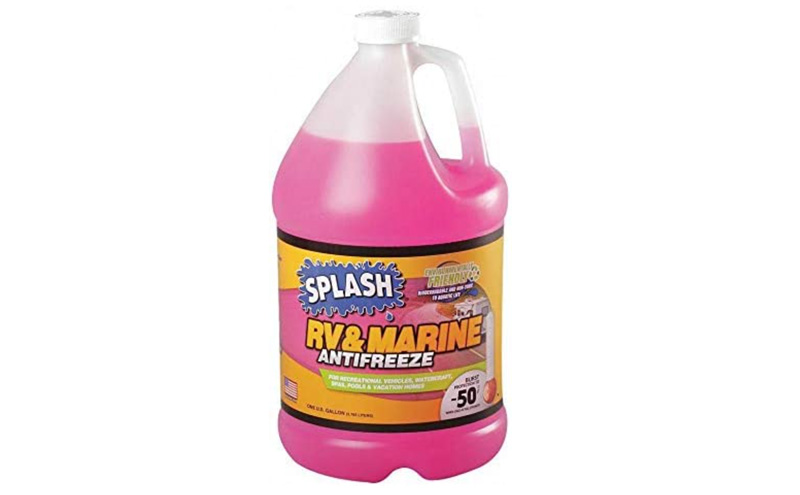
Though the Arctic Fox 992 is a four-season camper there are several things I have done to better handle the cold. First, I installed a second fan and control switch to keep the fans blowing warm into the basement. Second, we winterize the fresh water system and use marine antifreeze to flush the toilet. Third, I have placed reflective insulation in the AC unit to prevent cold air infiltration.
Fourth, I have installed insulation pads in the skylights. Fifth, I have caulked around the door and other penetration areas. Sixth, I have installed insulation in the enclosed area under the sink and in the closets. Seventh, I have insulated the inside of the propane and battery compartment.
Eighth, I installed self-heating lithium batteries. And finally, I installed a Camco Wave 6 catalytic heater to reduce propane consumption. I am also looking to install insulation in the windows.
We use the black tank during our trips. We keep the grey and potable water winterized. In order to use the black tank, we bring marine antifreeze to flush the toilet. This keeps the tank from freezing and allows us the time to find an open dump site.
“Prepare, prepare, prepare. Make sure you have the clothing, gear, propane, and the right attitude.”
The Arctic Fox is a well-built camper and it stays comfortable with the Camco Wave 6 catalytic heater running. We bring the camper up to temperature with the furnace or by cooking, and the portable heater does the rest. It is not 70 degrees Fahrenheit, but it is better than freezing. We also layer up on the bed with a 30 degrees Fahrenheit (-1.1 degrees Celsius) top quilt.
My advice is to make sure you do your homework to get your truck and camper winterized properly. Prepare, prepare, prepare. Make sure you have the clothing, gear, propane, and the right attitude. If you have lithium, get self-heating lithium batteries. Start out at a place where you can recover if things go sideways. Watch the weather as a sunny and cold day is better than a blizzard.
My wife and I love winter camping because of the solitude we find. It is so nice when there are no bugs, it’s snowing, and all you hear are the sounds of the wind and the local wildlife.” – Wayne Magro, 2016 Chevy 3500, 2020 Arctic Fox 992
“The coldest we’ve camped was -1 degrees Fahrenheit (-18.3 degrees Celsius) at my farm and home in St Louis. I stayed in my Lance 1062 testing my solar, electric space heater, and water systems.
The dump and water system did freeze even though I installed a 100-watt light bulb in the dump area. The frozen parts were the outside shower valve and the city water hookup. I had to replace both of them once they thawed. I am now using a DC heat tap in that area.
I also installed a shut-off valve and drain for the city water hookup. When you use internal water, a check valve in the city water hookup allows water in the fitting hose where cold is hard to keep from freezing. I am still working on how to keep that area of the camper warm in very cold weather.
I am good to 15 degrees Fahrenheit (-9.4 degrees Celsius) if I keep the camper temp at 65 degrees Fahrenheit (-18. degrees Celsius). I can heat the camper to 70 down to zero, but the gas furnace duty cycle is at 75 percent using a 20-pound tank in three days. Once the sun comes up, I have no problem staying warm.
“Getting out in the cold, snow and mountains can be wonderful even if you are old like me.”
I have had no problems if the camper is loaded on the truck. I have not tested this with my camper off the truck.
A twin bed electric blanket works great but you need 110-volt AC. It’s only three amps to stay warm at night. Using a small $25 space heater also works great if you have 110-volt AC.
You can stay warm off-grid with propane and solar only if you have a 2,000-watt inverter and 400 amps of lithium with a backup propane generator. Two 20-pound tanks will last about two weeks if you are hooked up to a 15-amp outlet.
Getting out in the cold, snow and mountains can be wonderful even if you are old like me.” – Allan Reeves, 2020 Ford F-450, 2020 Lance 1062
“My advice is to plan ahead. Murphy’s Law will bite you if you’re not prepared.”
“The lowest temperature has been -15 degrees Fahrenheit (-26 degrees Celsius), but the most difficult was -10 degrees Fahrenheit (-23 degrees Celsius) with a wind. Deer hunting in North Dakota in November often presents challenges. I hunt whitetail deer in the winter. My Lance is a four-season camper.
My empty farmyard has 120-volt electric and the old septic tank is still there.
I use an electric space heater to reduce propane use, but I make sure the propane furnace still runs enough to keep my holding tanks from freezing. I have learned that emptying a Porta Potti into the septic tank is easier than fighting black water dumps. So, I use the fresh and grey tanks, but not the black tank.
I use an 8-inch electric fan to spread heat under the cupboards and keep the water lines flowing. The fan also equalizes the temperatures between the cabover bed and the living area. The fan clamps to cupboard doors and a bedroom rack near the ceiling. If I keep the interior air moving there are few problems.
My advice is to plan ahead. Murphy’s Law will bite you if you’re not prepared.” – Philip Tron, 2009 Chevy 3500, 2013 Lance 1050
“The coldest we’ve camped is at about 10 degrees Fahrenheit (-12.2 degrees Celsius) at a truck stop in New Hampshire just off the interstate. The furnace was on most of the night, and the single battery was not enough to keep the furnace fan on the whole night. I had to start the truck up to keep it going. That experience was a wake up and led to me getting a new solar charging system hooked up to two Trojan deep cycle batteries. Since then we’ve had enough 12-volt battery power for cold nights.
We’ve stayed overnight at truck stops up and down the interstate and in a few states that allow overnight camping in rest areas. We use a big canning pot to heat water for hand towel baths. We have two-wheel drive, so we don’t do wilderness or off-road camping in extreme conditions. I would not choose to camp below zero for more than one night unless it was an emergency situation.
We have camped for over forty years in various Class C motorhomes, vans, and two truck campers. While not fearing to camp in really cold conditions, we know enough to prepare for it as much as possible and to know the capabilities of our camper and ourselves.
We are usually going between destinations when we very occasionally run into cold weather. Neither my wife nor I do any outdoor winter recreational activities. What we are passionate about is camping and being comfortable using the camper as often as possible.
“I strongly recommend putting anti-freeze in all the pipes and drains and don’t forget to also include opening the lowest point outside drain faucets in the system. That will get the anti-freeze into the last part of the system. Anti-freeze can look like a slushy in cold conditions.”
We only have single-pane windows. However, with little over-the-window Venetian blind trim boxes, my wife made semi-heavy curtains to hang over the windows when parked. These really help keep the sleeper warm. We also have a couple of pieces of half-inch pink foam covering the inside of the sleeper bottom, which works great. Finally, I installed some matching carpet on the bottom 2-feet above the full-length couch and lower front wall below the sleeper. That also helps.
If you want to go winter camping, make sure to bring enough water. You could keep it from freezing by having it in the truck cab while traveling. Or put the water in an ice chest in the camper. Fill all the propane that your camper can hold, just in case.
We do not run fresh water for the bathroom or sink during the winter months. I put four or five gallons of RV anti-freeze in the holding tank to use for flushing when we can’t find a gas station in time. We keep the sink and tub drains full with anti-freeze so summer drain water doesn’t freeze.
I bring an extra set of holding tank pull valves, in case stuff freezes in either tank. I also try to empty the tanks when getting to a destination, every day before stuff gets too cold. If we knew we were going into a sustained freezing situation, I would bring the honey bucket from our boat, just in case.
With the extra wall insulation, the sleeper insulation under the bed, the side curtains, and the carpet wall insulation, the camper gas furnace works fine if we are not plugged into shore power. If we are plugged in, an electric space heater is usually enough to complement the propane furnace on a lower setting. That means we don’t just depend on the electric heater. Our camper is aluminum framed and floored, so I went under the camper the first year we had it and glued one-inch pink foam insulation under the floor and between the floor frames.
I strongly recommend putting anti-freeze in all the pipes and drains and don’t forget to also include opening the lowest point outside drain faucets in the system. That will get the anti-freeze into the last part of the system. Anti-freeze can look like a slushy in cold conditions.
Always drain the propane water heater tank before traveling, and turn off the bypass valves feeding and releasing hot water. That avoids filling the water heater tank with five gallons of anti-freeze.
In a pinch, you can put large towels over windows in severe conditions. We keep our inside aluminum floor with a bottom layer of vinyl, a couple of hall runners on top of that, and some Walmart throw rugs as the top layer.
I wouldn’t say that we are called by the cold. We just plan ahead so we can use our camper at an overnight rest stop and go from point A to B – especially if point B is Florida.” – Frank and Kaye Mehaffey, 2012 Ford F-250, 2015 Camplite 10
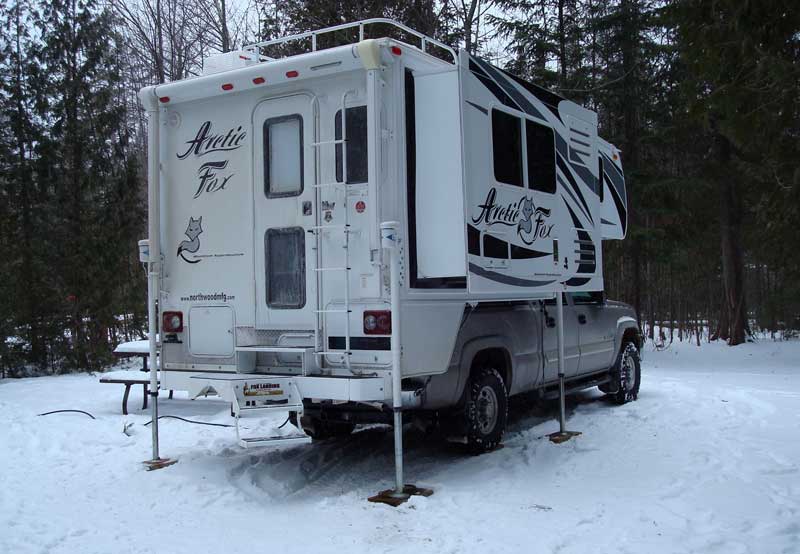
Above: MacGregor Point Provincial Park, Ontario
“The coldest we have been in a truck camper was about -20 Celsius (-4 Fahrenheit) at MacGregor Point Provincial Park in Ontario.
But, the coldest temperature that we camped in was -35 Celsius (-30 Fahrenheit). The wildlife is friendlier in the winter (and hungry). When it gets that cold, the trees crack and you can hear them snapping in the cold.
When traveling in our truck camper in the winter we do go to campsites with electricity. We need the electricity to keep the batteries charged since they would be depleted by the furnace fairly quickly. We stay in Provincial and National Parks where there are also heated washrooms and water available.
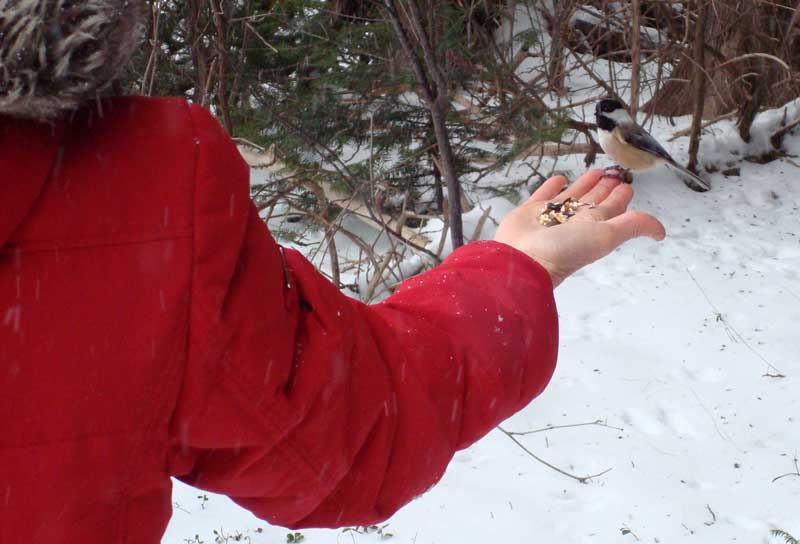
We enjoy hiking, skiing, tobogganing with the kids, snowshoeing, the quiet, warm fires, and no bugs. It is a very different experience to camp when there are only a few other or no other campers.
“It is a very different experience to camp when there are only a few other or no other campers.”
Our camper has double-pane windows so it is not very hard to keep the camper between 22 and 24 Celsius (71-75 Fahrenheit) with the furnace. We run one electric heater to take some of the load off the furnace and also to dry the air inside but we still need to cycle the furnace to keep the holding tanks warm.
The holding tanks in our camper are heated by the furnace. We use both the black and the grey tanks while camping but do not use the fresh water system. We carry in water to use inside.
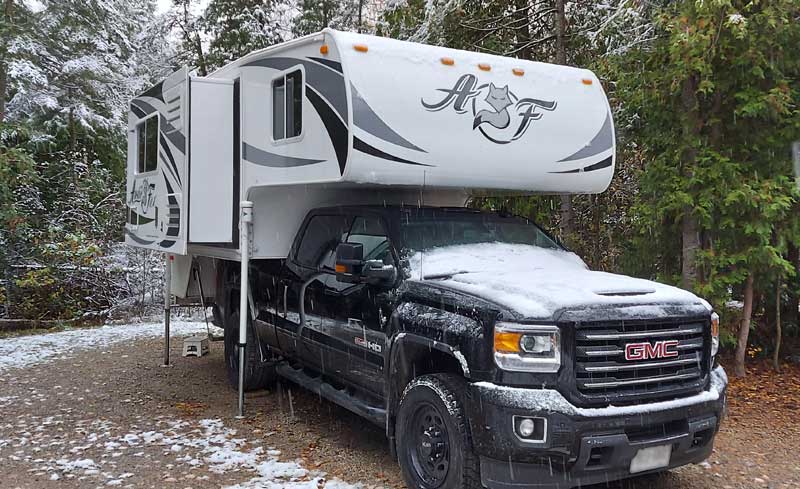
Above: MacGregor Point Provincial Park, Ontario
There is no problem staying warm. We do have a heated mattress pad that we use initially to warm up the mattress, but it gets too warm to sleep with it on.
The biggest issue with winter camping is when the propane tanks get cold the gas doesn’t vaporize very well, so the furnace doesn’t work. We put a 50-watt battery blanket in the bottom of the propane compartment to keep the tanks from frosting.
As Canadians, my wife and I started winter camping early in our relationship. We tent camped many times in below-freezing temperatures, down to -25 Celsius (-13 Fahrenheit) for up to five nights at a time. We have winter camped in a tent, in fifth wheels, and two different truck campers. The coldest temperature we experienced was -30 Celsius (-22 Fahrenheit). Needless to say, moving into a trailer or a truck camper is a huge upgrade from a tent!” – Keith and Shauna Fishwick, 2018 Sierra 3500, 2015 Arctic Fox 811
























